Anna Maria van Schurman
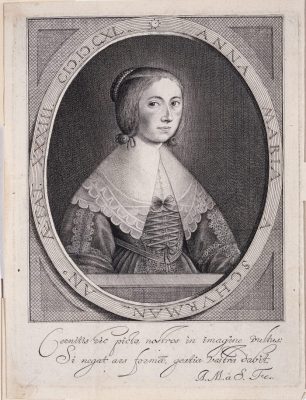
“Here only half of the gifted young woman is portrayed / for no frame can completely contain her.”– Antonius Aemilius, in Opuscula by Anna Maria van Schurman (1652 and 1749, frontispiece), trans. Pieta van Beek (2010, 96).
There is no more fascinating figure in early modern philosophy than the Dutch polymath Anna Maria van Schurman. A figure of renowned learning, an inspiring linguist who learned more than a dozen ancient and modern languages, van Schurman would have been a remarkable intellectual at any point in European history. The fact that she was a woman living in northern Europe in the early 17th century, a time when women were not only officially excluded from colleges, universities and intellectual academies, but also a time when they were rarely given any formal education at all, makes her all the more remarkable. She was a genius and recognized as such in her day. However, in other respects, van Schurman defies easy categorization. Textbooks concerning the history of science and the history of philosophy in early modern Europe are full of recognizable characters. There are the “schoolmen” and the “doctors of philosophy” promoting the traditional, Aristotelian-focused ideas promulgated throughout the colleges of early modern Europe. And then there are the radical figures who challenged the Aristotelians—the novatores or “moderns”—who made history. They were led by figures who quickly became famous for their anti-Scholastic methods and ideas, people like Galileo in Italy, Bacon in England, and Descartes in France and Holland. In a deep sense, van Schurman does not fall into either camp. That is not because she lacked views about Scholasticism and the various modern challenges to it. On the contrary, she expressed those views in depth in correspondence with various figures in her day. Rather, she charted her own unique path. In terms of her method, she displayed strong sympathies for Scholasticism, which stood in stark contrast to her friend Princess Elisabeth, who was more sympathetic to modern methods such as those of Descartes (Broad 2002, 17-19). But in terms of van Schurman’s ideas, she articulated a series of arguments in favor of women’s education that were equally challenging to the orthodoxy of European institutions at the time and to the moderns who sought to reshape those institutions in their own image. One is tempted to say that she put new wine in old bottles. But that old trope does not fully capture her unusual approach. In following a Scholastic method, especially in her famous Dissertatio, described below, she deployed an approach that would have been welcome to many of her interlocutors and certainly well known by the moderns who sought to challenge it. But in deciding to employ that method to endorse a conclusion about women’s education that was a serious challenge to nearly every male intellectual figure in Europe at that time, van Schurman greatly enriched the philosophical conversation of her day. Her work helps to underscore a profound fact that is easy to ignore. Despite their attempts to shake the very foundations of knowledge; despite their challenge to the orthodoxy of the schools throughout Europe in their day, the great “moderns” like Bacon, Descartes, Galileo, and Newton did nothing to challenge the prevailing gender norms governing philosophy and education in the 17th century. Their radical agenda, which eventually did overturn an intellectual regime that had prevailed for centuries, stopped at gender’s door. In that sense, the seemingly conservative and traditional Anna Maria van Schurman was perhaps more radical in her conception of education than the greatest thinkers of her age.
Van Schurman defies categorization in other ways. Renowned for her unmatched ability to learn both ancient—e.g., Hebrew, Greek, Latin—and modern—e.g., English, French, German—languages, she was also a poet, a philosopher, an embroiderer, and a painter. She made numerous striking self-portraits over the course of her career. In addition, her early years as a Dutch writer and intellectual figure of great fame were followed by her final decade in which she relinquished her worldly belongings in order to become the co-leader of a radical religious group associated with the French Protestant theologian and orator Jean de Labadie. In her early life, she was an inspiration and mentor to many men and women, including most prominently Princess Elisabeth of Bohemia, and a challenging interlocutor for many others, including most prominently Descartes. In her later life, she was an inspiration and mentor to many people who sought a new form of religious life, including most prominently the famous Quaker William Penn. Although some accounts portray van Schurman rather simply as a convert to Labadie’s theology, after Labadie’s death in 1674 she became a recognized leader of the movement and was sought out by influential figures like Princess Elisabeth and Penn for her thoughts about pressing religious issues at the time. In that sense, perhaps what most unites the various stages of her life is that many people in northern Europe, both the famous and the common, sought her out for her learning, her wisdom, her advice, and her leadership. She did not take her responsibilities lightly: she often expressed some trepidation about her increasing fame, and she was far from a self-promoter. Nonetheless, the historical record is replete with examples of people seeking her out for advice throughout her long life. For all of these reasons, her fame as an intellectual figure and scholar was “unprecedented” in this period (Pal 2012, 56).
| Preferred citation and a full list of contributors to this entry can be found on the Citation & Credits page. |
1. Biography
Anna Maria van Schurman was born in Cologne in 1607 to a family that had fled Antwerp during the last century and that was part of a Calvinist minority. They later settled in Utrecht in 1615, where she would spend her early years. The fact that she was from a family of religious exiles may have helped to shape important events later in her life. Early on, she demonstrated remarkable intellectual abilities, learned many languages, and developed a knack for philosophical argumentation. Her father taught her French, and when he noticed that she was correcting the Latin used by her brothers in their own lessons, he let her join their sessions. He then introduced her to classic authors like Seneca and also to Holy Scripture (Irwin 1989, 178). Unlike so many intellectual women in early modern Europe, her talents were recognized early. They were encouraged by many men and women in her milieu, and before long, she had achieved a level of fame rarely seen in this period of European history. Perhaps the most famous episode of her early life was her invitation in 1636 to deliver a Latin ode on the occasion of the opening of a new university in her home town of Utrecht. The beauty of her Latin oration quickly increased her fame, but in a sign that van Schurman was no ordinary Scholastic thinker, she challenged the professors at the new university to admit women students. Although her pleading in this case fell on deaf ears at an institutional level, van Schurman was personally invited to attend lectures at the new university. However, during the lectures she had to remain behind a screen, lest her presence disrupt the male audience (Larsen 2016, 275)! The ode and her status as the first woman in European history to attend any university or college greatly increased her renown. Already in May of 1638, Marin Mersenne, one of the most famous philosophical interlocutors and correspondents of the century, wrote that “she deserves to be among the illustrious women” (Larsen 2016, 49-50).
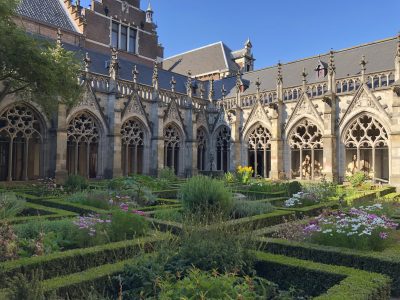
Amazingly, the tale of van Schurman listening to lectures from behind a screen circulated widely among Europe’s intellectual elite. Even Descartes mentions it in a letter to Regius, one of the most famous early Cartesians, during the summer of 1640. In an ironic twist, the lives of Descartes, Regius, van Schurman and her old Utrecht teacher Voetius were intertwined in a philosophical dispute. In June of 1640, Regius proposed a public discussion with Voetius in which they would argue their positions on a series of Cartesian ideas, including the circulation of the blood, a recent discovery by Harvey prominently endorsed by Descartes. The struggle between the two became quite personal and vicious, and eventually, Voetius was able to have Cartesianism banned from the university in Utrecht (Vrooman 1970, 150-66). It was in the midst of the early part of this intellectual debate that Descartes wrote to his young follower Regius from his home in Leiden, informing him that he would be happy to support him by traveling to Utrecht. He then joked that he could hide behind van Schurman’s screen in order to listen to the debates about his ideas at the university (see AT III: 70). Joking aside, Descartes did not take up van Schurman’s cause by arguing that women ought to be given a chance at an education at Dutch universities in this time. He complained to his friend Marin Mersenne in a letter from November 1640 (AT 3: 230-31) that he found Voetius to be very annoying and that the theologian had ruined van Schurman’s intellectual path by convincing her to focus on nothing but theological questions (see also Gaukroger 1995, 358-59). This difference in their approaches to theology would resurface when Descartes met van Schurman in person years later. [In their translation of this letter to Mersenne, Cottingham et al. (1991, vol 3: 156) misattribute her date as “Anne-Marie de Schurman (born 1612)”.]
Van Schurman’s early failure to convince the leaders of the new university in Utrecht to admit women did not deter her from pursuing that topic more substantially. In fact, she decided to make it one of her most significant intellectual pursuits. She began by engaging in an extended debate through extensive correspondence with the theologian André Rivet (see Clarke 2013, 94-108) just after delivering the ode in Utrecht. In 1637-38, Rivet and van Schurman exchanged courteous and respectful letters, but clearly disagreed with one another on the question of whether women ought to be afforded an education in the arts and sciences. Rivet seemed keen to limit the option of an education to certain special exceptions, such as van Schurman herself, a person he obviously greatly admired. He insisted that most women, especially girls and married women with various obligations, were in no position to receive a proper education, and he warned her against implying that women were superior to men. Van Schurman’s reply remained cautious and cordial, but she firmly argued again that education should not be restricted in the way that Rivet suggested. Instead, she thought, as long as girls and women did not shirk any of their social obligations—e.g., those undertaken through marriage—then they ought to be afforded a proper education. The lack of educational institutions, including colleges, that were open to women should be no impediment, van Schurman argued, because women could receive an education through home tutors. This idea obviously reflected her own early experience, but it may also have been an expression of a pragmatic approach to the problem at hand.
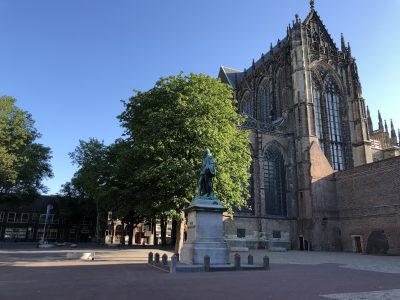
Rather than heed Rivet’s warnings and treat this highly controversial topic only in private correspondence, van Schurman took the courageous step of deciding to articulate her views for the public. She was also pressed into a somewhat rushed publication because in 1638, an unauthorized version of what would become her famous Dissertatio on the education of women was published in Paris (Larsen 2016, 186). The Paris edition, which appeared in Latin, was riddled with errors, so van Schurman published an authorized, corrected version with the famous Dutch publisher Elzevier in Leiden in 1641. This version, A Dissertation on the Capacity of Women for Education, greatly increased van Schurman’s fame. It was published in a French translation in Paris in 1646, under the title Question celebre, and was translated into English by the vicar and teacher Clement Barksdale and published in London in 1659 under the title The Learned Maid (Larsen 2016, 186). There have also been two modern English translations (Irwin 1998 and Clarke 2013). The publication of the Dissertatio in Latin, and its circulation in two vernacular languages, enabled van Schurman to accomplish two goals: first, the text allowed her to express her views in considerable depth, which correspondence generally prohibits; and second, it allowed her to expand her initial thoughts from her correspondence with Rivet into a properly formulated philosophical treatise (see “Section 4. Philosophy & Teaching” below for details).
Descartes’s joke that perhaps he should stand behind van Schurman’s screen in the lecture hall in Utrecht to listen to debates about his ideas was not his only encounter with the young Dutch polymath. Near the end of Descartes’s life, he met with van Schurman and discussed at least one important theological issue, the interpretation of the Book of Genesis. Unfortunately, scholarship on Descartes has been misleading on this point. The famous critical edition of Descartes’s Oeuvres edited by Adam and Tannery incorrectly identifies this important personal meeting between Descartes and van Schurman as having occurred sometime around 1640 (AT 4: 700-01). As evidence, the editors cite a number of letters among Descartes, Mersenne and Regius in 1640 and 1641, the letters that discuss Voetius’s supposedly negative influence on van Schurman, her genius, her screen for listening to lectures, etc. (see AT 3 71 note B; AT 3: 231). In addition to their discussion of van Schurman, Descartes also informs Mersenne in 1641 that in an effort to think about how his method of philosophizing could “accommodate” theology, he had thought about the interpretation of the first chapter of Genesis, an issue he later discussed with van Schurman. The story of Descartes’s final encounter with van Schurman, in which he chastised her for reading the Bible in Hebrew, and in which she was shocked and appalled by his impious attitude toward Holy Scripture, has circulated widely. Every Descartes scholar may encounter this episode easily because it is described in depth through a long quotation from the “Life of Jean Labadie of 1670” to be found in AT 4: 700-01. In fact, Adam and Tannery, the editors of Descartes’s Oeuvres, were not quoting directly from that late 17th century text, but rather from another text that describes Descartes’s relation to yet another famous 17th century woman, Princess Elisabeth [Foucher de Careil, Descartes et la Princesse Elisabeth (Paris, 1879), pages 150-52, which is apparently based on the Vie de Jean Labadie of 1670. The episode can also be found in Gustave Cohen, Écrivains français en Hollande dans la première moitié du xviie siècle (Paris 1920), pages 536-38].
However, as the primary accounts from the period indicate, Descartes’s fateful meeting with van Schurman actually occurred in 1649, when he was traveling to Sweden to sit in the court of Queen Christina. On his way to Sweden, Descartes stopped in Amsterdam to visit his publisher (Rodis-Lewis 1992, 48) and also stopped in Utrecht to see van Schurman. The tale was first told in a contemporaneous account by Pierre Yvon in his Abregé sincere de la & de la Conduite & des vrais sentiments de feu Mr. De Labadie [which was reprinted in Supplementa illustrationes und emendationes zur Verbessurung der Kirchen-Historie, ed. by Gottfried Arnold, Frankfurt, 1703, pages 282-83]. The visit did not go well. As the two philosophers sat and chatted, Descartes noticed a copy of the Hebrew Bible on van Schurman’s desk. He asked her why someone of her erudition and talent would waste her time reading the Bible in Hebrew, its original language, when it was of such little importance. As one would expect, van Schurman was deeply offended by this remark. She replied that one could not understand Holy Writ without reading it in the original, for no translation could truly do it justice. He replied that he had once attempted to interpret the first book of the Hebrew Bible, Genesis—reflecting a comment he had written to Mersenne years earlier—but had been unable to make much headway in understanding the words of Moses (cf. AT 4: 700-01). She was greatly surprised by his attitude, and resolved at that moment never to hold a discussion with the French philosopher again. As fate would have it, they could not have met again anyway: Descartes traveled to join Queen Christina’s court in Sweden a short time thereafter, and died in Sweden the next year.
Ultimately, van Schurman was not satisfied with the life of intellectual fame in Utrecht that she had forged for herself in her early years. She certainly stood at the center of an impressive, international network of scholars and philosophers (Pal 2012). As Anne Larsen shows in her extensive biography, van Schurman’s correspondents and interlocutors included Queen Christina of Sweden, Marie du Moulin, Descartes, Mersenne, Gassendi, Constantijn Huygens, Princess Elisabeth of Bohemia, Dorothy Moore in England, William Penn, etc. Van Schurman corresponded with these figures, and many more, in Dutch, French, Greek, Latin and Hebrew. By the early 1640s, her fame extended throughout Europe. And yet for all this, van Schurman did not feel satisfied. Perhaps she felt that she lacked a true community. In the event, she made a radical choice late in life: having met a former French Jesuit by the name of Jean de Labadie, who had developed a reputation as a famous preacher and radical theologian, she decided to relinquish her comfortable life of fame in Utrecht and begin a trek across much of northern Europe as a member of Labadie’s growing community of believers. This decision would carry her for roughly the last decade of her life (she died in 1678). The famous story of van Schurman’s last encounter with Descartes is relayed from a nearly contemporaneous account originally written in 1670, a text concerning the life and teachings of Jean de Labadie written by one of his acolytes, Pierre Yvon. Van Schurman’s life among the Labadists contains many intriguing clues to her developing ideas about education, philosophy, theology and religion. Her choice to follow Labadie is especially interesting.
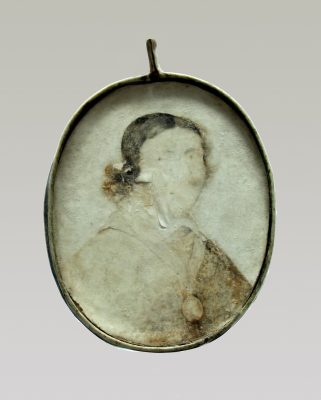
Jean de Labadie was a French religious figure of considerable importance in the mid-to-late 17th century; he gathered a significant following and caused a number of religious and political disturbances in the course of his life. As a young man from Southwest France, Labadie began his studies as a Jesuit and soon gained a reputation as a fiery orator and compelling speaker. However, by late 1638, he requested that he be allowed to leave the Jesuit order, a request that was granted the following spring.
This action was the first in a long line of such moves by Labadie: throughout his life, he joined one religious group or another, only to decide later that his co-religionists did not meet his spiritual requirements. He was also something of a rabble rouser. Over the years, he lived in, and was eventually chased out of, Paris, Port-Royal, Utrecht, Herford, and Amsterdam (Pal 2012, 238ff). It was therefore not surprising that he decided in the end to found his own religious community, and found it difficult to settle his community in a permanent home. Before he began his own sect, however, he traveled extensively in northern Europe, joining one group or another for a time, then breaking with their doctrine later. For instance, after leaving the Jesuits and traveling widely, he eventually made his way to the free Calvinist city of Geneva. He quickly made a strong impression there: within a month of his arrival in 1659, he had become a pastor in the Calvinist church and was soon a wildly popular orator, one known widely for his three-hour sermons (Saxby 1987, 11-15, 105-6). Despite his great success, he also had a knack for upsetting powerful people: it turns out that at this time, he had already promised a congregation in London that he would become their minister. Quite soon after, the Speaker of the Long Parliament in England, William Lenthall, who had famously defied King Charles years earlier, wrote to Geneva objecting to Labadie’s stay there. Eventually, this dispute was resolved, but Labadie was not destined to remain in Geneva for long. Although the leaders of the city asked him to stay, by 1666 he had decided to forge a new path once again. This time, Labadie and his growing following traveled together to Utrecht where they stayed with Anna Maria van Schurman for ten days. Labadie had met van Schurman’s brother Johann in Geneva years earlier, so he was confident that he would find a welcome refuge at her home in Utrecht (Saxby 1987, 117-18, 129, 138-9). This initial short stay would radically alter van Schurman’s life as well as Labadie’s philosophy. He dedicated his next work, Le triomphe de l’Euchariste, to van Schurman because (he said) they shared an understanding of the Christian spirit. Not long after this initial visit, van Schurman made a radical decision: she resolved to leave her comfortable life in Utrecht as a famous intellectual figure and join the growing, but itinerant, Labadist community. In 1669, van Schurman and several others, including her maid and her nephew, traveled to Amsterdam and stayed on the ground floor of Labadie’s new home there. Van Schurman’s friends considered this to be a seriously controversial and unwise decision (Pal 2012, 238-44; Saxby 1987, 177), and her time in Amsterdam was marked by the local community’s skepticism, and even outright hostility, toward Labadie and his followers. Van Schurman was perfectly well aware that her decision would be controversial, but chose it anyway (Irwin 1989, 180-1). Even in the famously freethinking and liberal city of Amsterdam—a reputation it enjoys to this day—the Labadists were considered radicals who challenged political and religious institutions too sharply and forcefully. The citizens of Amsterdam objected to Labadie’s public contention that no institution had the right to legislate against the conscience of individual believers and communities like theirs (Saxby 1987, 156). Consequently, in 1670, the Labadists decided to follow van Schurman’s lead by seeking refuge in the Abbey at Herford controlled by her old friend from the Hague, Princess Elisabeth of Bohemia, a powerful royal figure who van Schurman had mentored in her youth. It was another fateful choice. Princess Elisabeth had welcomed van Schurman and her community to enjoy the free land under her control within the larger Prussian Empire (in present day Germany). Roughly fifty of them arrived at the Abbey, with van Schurman and Labadie at their head (Saxby 1987, 197), in October of that year.
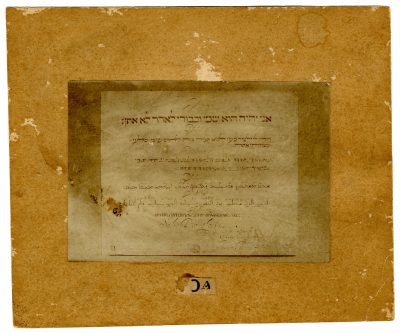
The Abbey at Herford was founded in 820 and included considerable lands around the town in which it was situated. The convent had survived the Reformation, and became a Protestant institution. As the Abbess, Princess Elisabeth and the two dozen members of the Abbey enjoyed significant autonomy: their lands were known as “Stifts-freiheit” or independent lands within the Duchy of Brandenburg-Prussia—this meant that the Princess was formally required to report only to the Emperor himself. These conditions must have given van Schurman and the Labadists confidence that they may have finally found a stable home for their growing but controversial, if not persecuted, community. Certainly, they all placed great faith in Princess Elisabeth’s judgment and influence, and she had ensured them that her cousin, Elector Friedrich William of Brandenburg, had given her official permission to provide refuge to Labadie and his flock. In a clever move, Princess Elisabeth described the Labadist community to her cousin as a “convent” led by the now famous van Schurman, noting that Labadie was their preacher (Pal 2012, 246-48). Alas, controversy continued to follow their young community. Although the Abbey provided van Schurman and the Labadists with a safe haven, the surrounding townsfolk did not share Princess Elisabeth’s open mindedness and liberal attitude toward religious pluralism. Like the community in Amsterdam, the people of Herford and environs were greatly displeased that a controversial group of religious refugees had settled in their town. They expressed their displeasure to the local authorities, hoping that they would send the Labadists on their way. When this failed, they took matters into their own hands: they smashed windows in van Schurman’s bedroom, pelted the Labadists with mud as they walked through town, and even tried to prevent them from drawing water at the local well (Saxby 1987, 199). It can be difficult for us to understand these events now, so it is beneficial to remember that this was a time of great religious strife throughout both Britain and Continental Europe, with numerous conflicts and wars involving religion and factionalism. In addition to the well-known conflicts between Protestants and Catholics, the Labadists, like the Quakers and others, were part of the growing number of new Protestant sects that not only rejected Catholicism, but also the authority of the more recently founded Lutheran and Calvinist churches that existed in many regions throughout northern Europe. This helps to explain the actions of the townspeople of Herford, but from another point of view, it also helps to underscore how profoundly important Princess Elisabeth’s liberal attitude toward religion was at this time. She knew, as did van Schurman, that she was taking a great risk in providing refuge for their band of religious radicals, just as Labadie and van Schurman were taking a great risk in separating themselves from all forms of established religion at that time. Moreover, by deciding to stay under the Princess’s protection in Herford, everyone involved was consciously testing the limits of local political control within the larger context of the evolving boundaries of Brandenburg-Prussia in the late 17th century.

For a time, van Schurman and her community of exiles remained safe under Princess Elisabeth’s care. In June of 1671, the Elector officially decreed that he would be continuing the policy of toleration that his cousin Elisabeth had been advocating, thereby allowing the Labadists to remain unscathed in Herford. However, this liberal policy clearly did not reflect the sentiments of the local townspeople (Saxby 1987, 207). From their point of view, the Labadists were hidden Jesuits—this was a Protestant region that would be expected to reject Catholic influence—and also, somewhat incongruously, secret Quakers (Saxby 1987, 208). The local peace was not destined to last: after much struggle and continuous claims of heresy by the local people, a strong ruling against the Labadists was finally passed. At the end of October, 1671, the Reichskammergericht, which asserted its authority over Princess Elisabeth’s lands, ruled that the Labadists were actually a radical sectarian group filled with Quakers and Anabaptists, and that they therefore must leave the lands where only Lutherans and Reformed Protestants were legally allowed to live (Saxby 1987, 210). However, Princess Elisabeth continued to believe that she possessed the ultimate authority to determine the fate of the community living on her lands, so she undertook a long journey to Berlin to appeal the proclamation of the council. After an extensive deliberation, she prevailed: in early May of 1672, the Elector proclaimed that the council had overstepped its bounds and instructed them not to undermine the Labadists any further (Saxby 1987, 216). However, by this time, the damage had been done: van Schurman and Labadie decided that they had probably overstayed their welcome in that region of Prussia, despite Princess Elisabeth’s heroic efforts on their behalf, so they resolved to find another home for their community.
The Labadists< left Herford and eventually settled in Altona, a town which was then under the dominion of Denmark (it is adjacent to present-day Hamburg). Although they remained for just two years, from 1672-74, two important events in the life of the community took place there. First, in 1673 van Schurman published one of her most influential works, Eukleria, which has been called “the most significant of all Labadist writings,” and which was widely praised, including by Leibniz (Saxby 1987, 225). Second, after a long life of religious fervor and years of exile, Jean de Labadie died in February of 1674, leaving van Schurman as the leading intellectual figure in their still growing community. She has also been called their “spiritual leader” (Hull 1935, 10). In order to find a more permanent and safe home, the community of several hundred believers moved again, this time taking up residence in Wieuwerd, a small village in the Netherlands east of Groningen and near the coast. A community of several hundred Labadist followers remained there for a number of years (Irwin 1998, 9). It was here in May of 1678 that van Schurman died, at the age of seventy (Larsen 2016, 66-67).
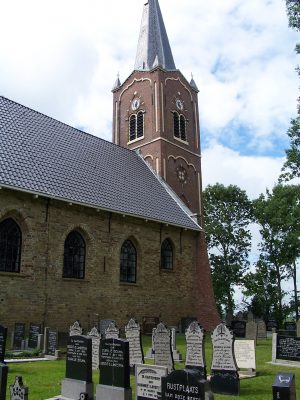
It is ironic that the townspeople of Herford regarded Labadie and his followers as secret “Quakers,” because when the Quaker William Penn first visited the Labadists in October of 1671 at Elisabeth’s Abbey in Herford, he was greatly offended by what he regarded as their inhospitable attitude toward him and his cause. He wrote a long letter to Labadie and his followers that same month, criticizing them for their wayward ways and also for what he regarded as their lack of hospitality (Penn 1981, pp. 215ff). He even made some of his sentiments public, proclaiming in November 1672 in an open letter (entitled “Plain Dealeing”) that the Labadists had improperly lifted Labadie above his true station (Saxby 1987, 209-10). If nothing else, it was clear already from this first encounter that the fortunes of these two newly founded, controversial religious sects, the Labadists and the Quakers, would be intertwined in various ways. Some scholars think that Penn and the Quakers sought support from Princess Elisabeth because she had shown such clear resolve in attempting to promote toleration for van Schurman, Labadie and their followers (Hull 1935, 39-40). They sought toleration for their views as well, especially at a time in European history when the term “Quaker” was often seen as a term of abuse. For his part, the Quaker leader Penn was clearly committed not only to seeking Princess Elisabeth’s support, but also to forging an alliance with van Schurman. Although he never saw Labadie again, Penn found the time in his arduous travels around Europe promoting the Quaker message to meet once more with both van Schurman and Princess Elisabeth. He visited Elisabeth in Herford a second time, in August of 1677, and later wrote her an extensive letter attempting to convince her of his religious and theological views, warning her to avoid the temptation of following the devil [the letter is reproduced in its entirety in Bulletin of the Friends Historical Society of Philadelphia, vol. 4 (1912): 86-97]. Among other things, he tried to convince Elisabeth that some of the ministers and priests living under her protection were idolaters. Despite the sometimes overly optimistic portrayals of his biographers, one of whom characterized Elisabeth as convinced of the truth of Quaker doctrine (e.g., see Janney 1853, 126-27), Penn’s efforts were not terribly successful, as evidenced by Elisabeth’s rather terse reply to his entreaties. In her reply, which she wrote to him in late October 1677 (Bulletin 1912, 97), she did not take up any of his principal recommendations in detail, preferring to remain vague on each significant religious point, although she had adopted a friendly tone. Penn remained undeterred: soon after his visit to Elisabeth, he once again sought out her old friend, van Schurman, presumably this time as the intellectual leader of the Labadist sect. In the famous journal of his travels in Holland and Germany, which was later found among the papers of Anne Conway, Penn records some details of this second visit to van Schurman and the Labadists (Janney 1853, 125; Penn 1981, 473-74). Although he judged the first visit a failure, when he was insulted by his “unhandsomely” treatment by Labadie and his followers, Penn found the second visit, which occurred in September of 1677, far more congenial. He had hoped especially to meet personally with van Schurman during the second visit, since he had not been allowed to see her during the first. After arriving during the evening, they were brought into van Schurman’s chambers the next morning, thereby accommodating her poor health. The meeting was obviously important to van Schurman as well, since she was unable to walk by this time. Here is Penn’s description of her: she is an “Antient made above 60 years of Age, and of great note & fame for learning in Languages & philosophy; & hath obtained a considerable place among the most learned men of this age.” During their time together, Penn asked van Schurman and the other Labadists gathered in her room why they had decided to separate themselves from ordinary society and what he called “the common way,” a question that obviously went to the heart of their endeavors. Each person in attendance answered his question in turn. He records van Schurman’s answer as follows. She told Penn that she wished to add “a short Testimony” to what others had said (Penn 1981, 474). He summarizes that testimony thus: “She told us of her former life, of her pleasure in learning, & her love to the religion she was brought up in: but confessed, she knew not God or Christ all that while. And though from a child God had visited her at times; yet she never felt such a powerful stroak, as by the ministry of de Labade. She saw her learning to be Vanity; & her religion like a body of death. She resolved to despise the shame; desert her former way of living & acquaintance; & to joyn herself with this little family, that were retired out of the world: among whom she desired to be found a living sacrifice offerd up intirely to the Lord.—She spoke in a very serious and broken sense, not without some trembling. These are but short hints of what she sayd.” [Both quotations: page 474 of The Papers of William Penn, vol. 1: 1644-1679, edited by Mary Maples Dunn et al. Philadelphia: University of Pennsylvania Press, 1981.] Penn’s description of van Schurman’s personal religious attitude is obviously of great significance both for understanding the development of early Quaker attitudes toward rival religious sects and also for understanding van Schurman’s own sense of the development of her life. This is also close to van Schurman’s final testament: she died just months later in 1678.
It is tempting to follow Penn’s description by dividing van Schurman’s life into two distinct periods: an early time of learning, philosophy, painting, and literature, and a later era of religious conviction and the rejection of her previous secular ways. Underlying the division, however, one might also find an intriguing thread of unity: throughout her long life, van Schurman was a woman of great conviction, and also a confident and independently minded person. She very deliberately did not allow the gender norms of her day to prevent her from achieving a deep education and a level of intellectual fame that was simply remarkable for any woman at the time. Later in life, although she rejected the secularism of her education and earlier pursuits, she nonetheless continued to pursue her own independent, not to mention risky, path in life, leaving behind her life of comfort and fame in Utrecht to join and eventually help to lead a band of religious converts whose choices would lead to their rejection and persecution in several countries. Van Schurman understood perfectly well that her early choices exposed her to criticism: she not only chose to write a work defending the education of women, a controversial topic in itself, but she also chose to embody that very life in her own person. Similarly, she did not merely defend religious toleration and freedom of conscience, she chose to embody those very principles in her personal choices at the end of her life, living in exile for a decade in accordance with her newfound beliefs. It is easy to understand why Anna Maria van Schurman, since her earliest days, has been an inspiration to so many others.
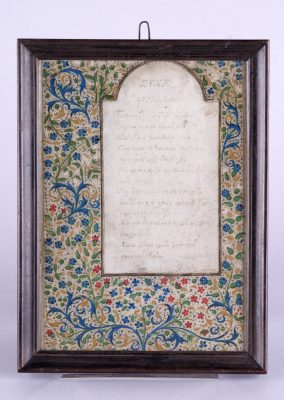
The lives of philosophers are often categorized into distinct periods, the province of the scholar. Leibniz has his early, middle, and late years, Kant his pre-critical and critical years, Wittgenstein his early and late periods, and so on. The lives of saints and religious heroes are often categorized into the worldly years, or the years marked by sin, and the holy years, or the days after a conversion or religious experience. In similar sense, Anna Maria van Schurman’s life has two distinct periods, not just on intellectual or philosophical grounds, but on religious ones as well. In her autobiography, Eukleria, published late in her life in 1673, she distinguishes these two periods and marks off her later years, the days when she was part of the Labadist community, as lacking in the worldly vanity that characterized her early years. As a young woman, as we have seen, van Schurman was immersed in a scholarly and intellectual world, and became increasingly famous for her erudition, insight and knowledge. In her final decade, she seemingly shunned this worldly, scholarly existence for a more contemplative, religiously infused life as a member of a community of outcasts and religious exiles. It is therefore quite tempting to divide her life neatly into two categories: her early years as a secular intellectual who worked at the heart of a major international network of scholars and philosophers, and her later years as a religious figure who worked at the center of a community of exiled religious thinkers and practitioners. The notion of a secular life, and of a secular community, in contrast to a religious one, employs categories that are all too familiar to the contemporary reader. Tempting as it is, however, this neat division of van Schurman’s life is anachronistic; it also misses some of the subtlety in her later work. There is no doubt that van Schurman herself divided her life into two distinct periods. But instead of distinguishing the early “secular” years from the late “religious” ones, it is more accurate to note that the division reflects a shift in her religious or theological views. Far from having a “secular” childhood and early adulthood, she tells us that she held religious and theological views in her early years that were of great importance to her; later in life, however, those views had shifted, and that shift, in turn, put her early years of study and learning into a new light for her. There is no doubt that some of the more forceful passages in Eukleria, her late autobiography, encourage her readers to interpret her life as falling into two sharply divergent periods. At times, she seems to denounce the frivolity of her youth, her youthful failure to understand the importance of the love and worship of God, her vanity in increasing her fame through study and publications, and so on. The seriousness of purpose of her late work, coupled with her intense focus on the righteous path for a Christian life, can leave one with the impression that she decided to completely reject her earlier life, its concerns and its very reason for being. But as one would expect from a philosopher like van Schurman, these passages occur within the larger context of a text that attempts to present a detailed, complex and subtle account of the change in her life’s circumstances, of her decision to leave the scholarly life behind in favor of committing herself entirely to a community of religious exiles led by Jean de Labadie. It is obvious that the details, the complexity, and the subtlety meant a great deal to van Schurman, and so they must be our guide in trying to understand her life today.
In a sign of the fame that she had acquired, the very fame that she bemoaned in certain regards later in life, van Schurman tells us at the outset of Eukleria that her goal in this text is to explain her change of life to her readers. She wants us to understand why she decided to forsake the life of a scholar for the life of a religious exile. Ironically, she approaches this task as a scholar would: she writes a detailed text in Latin with the aim of describing her life! Moreover, she approaches her task not merely as a scholar, but as a philosopher: she proclaims early on in Chapter One that she must provide reasons and arguments to defend her stark change of life—a sure sign that she had not relinquished the commitment to philosophy evident in her early writings. One of her principal arguments is that she wished to relinquish what she took to be her own vanity in her youth: she thinks in a sense that her early fame as a scholar, linguist and artist went to her head, causing her to develop a kind of self-regard and self-love that was not appropriate for a young Christian. That is, she found it difficult to maintain her humility in the face of the great fame that she had achieved. In a memorable phrase, she says that her early years were marked by a kind of “literary idolatry” (Irwin 1998, 78). She shows her philosophical stripes even more clearly when she enriches her account with what must be one of the only autobiographies to include an imagined objection to her own account of her life! She objects to herself as follows: certainly, one can understand that your early fame involved excessive praise from others, but surely your learning and study itself was appropriate. Her reply to this objection nicely expresses the subtlety of her views. She does not take this opportunity to shun learning altogether, or to proclaim that all education involves vanity. Instead, she notes that study and learning on occasion involve too much vanity. More importantly, she wishes now to place the study of the arts and sciences into a new context: the aim ought to be for the pupil to focus on those things that pertain to God purely and truly (Irwin 1998, 79). She reiterates and deepens this point in section 19 of Chapter Two: the true teacher needs not only Holy Scripture (“the book of God”), but also the book of nature, and of course, the latter book cannot be understood unless one has training in the arts and sciences. So her aim in her later years is not to reject “secular” education, as we might think of it today, but rather to underscore that the aim of education must be to bring the pupil to an understanding of God’s creation (a view that was, of course, exceedingly popular throughout the century). The study of letters is to be commended, but she again warns her reader that many who study are vain. This reading of her text is supported by her discussion of her youth in Chapter Two. She tells us that from a very early age, she felt piety. She vividly remembers a day when she was just four years old and she felt a surge of love for God as she recited the Heidelberg catechism (Irwin 1998, 79-80). In a foreshadowing of her later years, as a young person she always disliked preachers and neighbors who were not truly Christian in their actions (Irwin 1998, 87-88). She was skeptical of people who followed the letter, but not the spirit, of Jesus’s teachings. In this sense, there is an important continuity in van Schurman’s life. She ends Chapter Two with a memorable remark: she tells us that she knows for certain that the one argument that is most effective against the errors of atheists is in fact a life that has been lived in accordance with Christian virtues (Irwin 1998, 94). This focus on action late in life, rather than on purely intellectual or scholarly pursuits, has an analogue in Princess Elisabeth’s life, and shows that van Schurman was not merely a philosopher in writing, but in action.
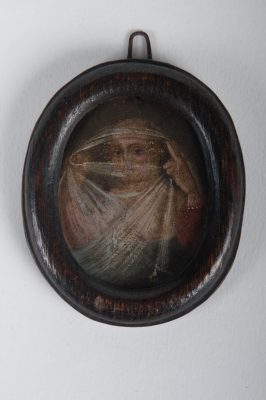
For image sources and permissions see our image gallery.
1.2 Work as an Artist
In her lifetime, Anna Maria van Schurman had several nicknames that referenced her intellectual accomplishments. One among these was the “Utrecht Minerva,” a nod to the patroness of arts and sciences from Greco-Roman antiquity. This name indeed captures the Dutch scholar’s lifelong engagement with the arts, particularly with portraiture. van Schurman lived during the early Golden Age (1588-1647), a period of rich cultural development in the Dutch Republic (Larsen 2016, 8). It is necessary to contextualize van Schurman with other painters and engravers from this period, such as Rembrandt van Rijn (1606-1669) and Frans Hals (1582-1666), who were also known for their portraits. Yet in her autobiography, van Schurman never showed much desire to become a professional artist; instead, she considered her artistic practice as a diversion from her other humanistic pursuits (van Beek 2010, 20; van der Stighelen 1996, 57). The arts nevertheless played an integral role in the formation of her international reputation and in how she forged intellectual networks, notably among female rulers, artists, and writers such as Queen Christina of Sweden, Marie Le Jars de Gournay, and Anna Roemers Visscher (van Beek 2010, 148, 150-151, 157).
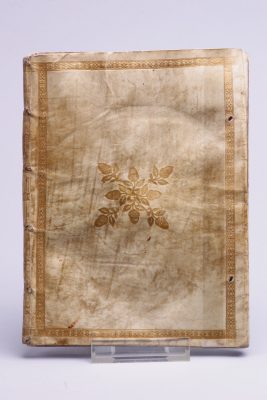
Education
The artistic education van Schurman received as a young girl included drawing, painting, sculpture, printmaking, embroidery, and paper cutting. Unlike most early-modern women artists who trained with a father, brother, or husband, van Schurman did not have any professional artists in her immediate family (Harris and Nochlin 1979, 41; van der Stighelen 1996, 58). However, her autobiography probably overemphasizes the extent of her self-teaching (Honig 2001, 33; van Beek 2010, 20). Scholars have connected van Schurman to Utrecht-based engravers, the van de Passe family. In the 1630s, she probably apprenticed with Magdalena van de Passe, whose father, Crispin van de Passe, did an early portrait engraving of van Schurman, a copy of which is now held at the Rijksmuseum in Amsterdam (Honig 2001, 33; van Beek 2010, 20; van de Stighelen 54, 61). There is also some speculation that van Schurman received drawing lessons at Gerard Honthorst’s studio, where she would have met Princess Elizabeth of Bohemia (Birch 1909, 28; van der Stighelen 1996, 63). In 1643, van Schurman was accepted as a painter, sculptor, and engraver to the St. Luke Guild in Utrecht, but this was only an honorary title and does not confirm her as an active member of that guild (Honig 2001, 33; van der Stighelen 1996, 58, 65).
In addition, van Schurman’s parents had an impressive collection of paintings at their Utrecht home which could have inspired the young artist (van der Stighelen 1996, 60-61). Yet she appears to have preferred the handicrafts, such as embroidery, paper cutting, and drawing, which were popular among noblewomen and amateurs (van der Stighelen 1996, 57, 65). It is likely that she acquired these skills from female members of her family (van Beek 2010, 44).
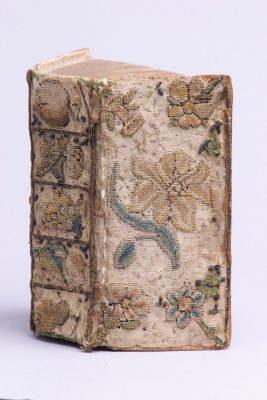
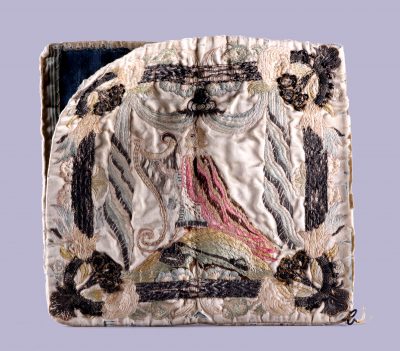
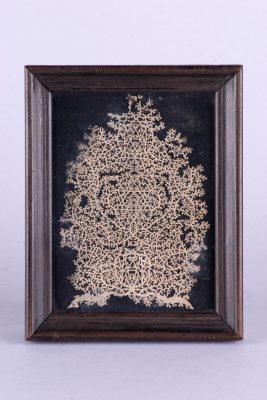
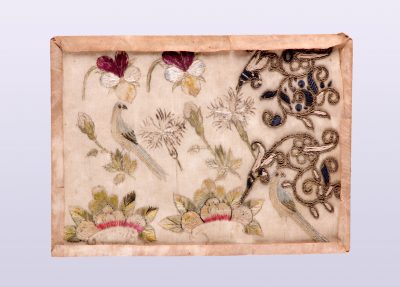
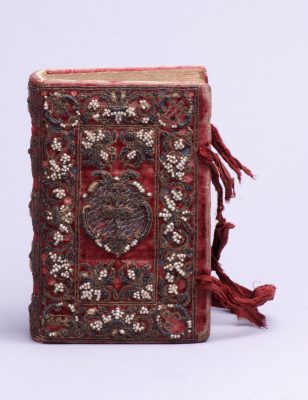
Portraits and Self-Portraits
Self-portraiture was a common pursuit for early-modern women artists, who rarely had access to models and studio space. It was also considered a socially acceptable way for such women to convey their talents (Harris and Nochlin 1979, 27-28, 41; van der Stighelen 1996, 55-56). In this sense, Anna Maria van Schurman was no exception. She experimented with self-portraiture using various techniques, such as gouache, oil painting, wax- and boxwood-carving, engraving, and pencil and pastel drawing. She was in fact the first Dutch artist to use pastels (van der Stighelen 1996, 65).
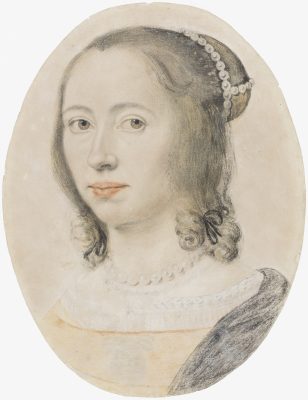
Van Schurman also painted portraits of other people, but only a few are known today. Some extant examples include miniatures of the theologians Jean de Labadie and Gisbertus Voetius, as well as van Schurman’s brother, Johan Godschalk van Schurman (De Baar 1996, 76, 97, 120). Van Schurman also demonstrated her proficiency in calligraphy and poetry by writing in others’ alba amicorum or “friendship albums,” books that contained their owner’s collection of autographs and visual memorabilia (Honig 2001, 32-33; van Beek 2010, 26).
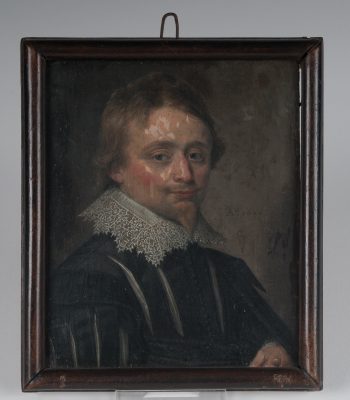
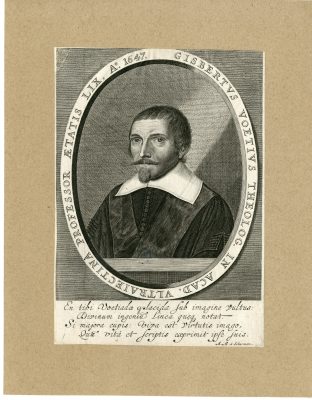
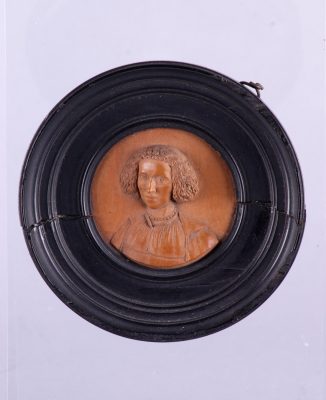
Considering van Schurman’s experimental techniques and preference for working on a smaller scale, one may be inclined to label her an amateur artist. However, it is clear by the wide dissemination and remarkable consistency of her portraits that van Schurman considered her image as integral to her professional reputation. This speaks to her commitment to a female “Republic of Letters,” in which illustrious women across Europe exchanged their letters, ideas, and artworks (Larsen 2008).
The following extant images of van Schurman showcase her longstanding commitment to portraiture as a means of self-fashioning. While one is her earliest known engraved self-portrait, the other is a commissioned portrait done when van Schurman was at the height of her international career.
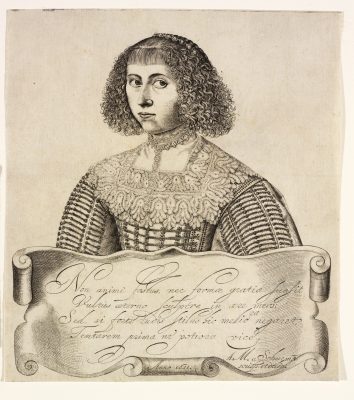
In this 1633 engraving, van Schurman presents herself in a modest but intricately wrought dress. She avoids the viewer’s gaze and hides her hands behind a quatrain that she composed. The Latin text reads, “No pride or beauty prompted me to engrave my features in the unforgiving copper; but [it was] because my un-practiced graver was not yet capable of producing good work, [and] I would not have risked a weightier task the first time” (Translation by RISD Museum). Van Schurman sent this early engraving, likely made during her apprenticeship with Magdalena van de Passe, to several people in her intellectual circle, such as Constantijn Huygens and Caspar Barlaeus. Both men responded with poems in which they interpret van Schurman’s decision to hide her hands as a reference to her virginity. But, this omission may simply have been a way for the young artist to conceal her inexperience with engraving certain features (van Beek 2010, 35-37). On the other hand, van Schurman did display her skills at calligraphy in the elegant script of her Latin poem.
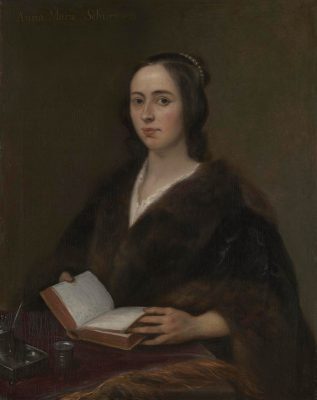
Another notable depiction of van Schurman is a 1649 oil painting done by the Dutch artist Jan Lievens. Despite being completed 16 years later, this portrait shows its sitter with softer features and more conventional signs of beauty. Lievens’s use of color and light contrast in this work prioritizes the sitter’s intellect. While van Schurman’s body appears cloaked in darker fabrics, her face and book are both illuminated, thus emphasizing her knowledge and writing skills. The concentration of white brushstrokes in the middle of her forehead further highlight her brilliance. Her social status is indicated by her fur-trimmed robe and silk chemise, and by a decorative rug that covers the table. The string of pearls wrapped around van Schurman’s hair is connected to a subtle black veil, which reinforces the image of her elegance and piety. Despite the prevailing sentiment of modesty in this portrait, there are certain elements that suggest the model’s sensuality, namely the rosy hue of her lips and cheeks and her direct, lively gaze. In contrast to the more anxious look given in her engraving, van Schurman here stares out confidently and communicates an awareness concerning her representation. Indeed, Lievens’s portrait bears striking similarities to a pastel self-portrait van Schurman had completed in 1640 (above), suggesting that this painting was a close collaboration between the artist and sitter (Larson 2016, 267-268).
For image sources and permissions see our image gallery.
1.3 Chronology
| DATE | EVENT |
| Nov. 5, 1607 | Anna Maria van Schurman is born in Cologne, in the house ‘De Cronenberg’ at the ‘Krummer Buchel.’ She is born into a well-off patrician family. At three years old, she and her family flee from religious intolerance and arrive in the Netherlands. |
| 1615 | The van Schurman family moves into the house “Achter de Dom” in Utrecht, where Anna Maria resides for the next forty years. |
| 1618 | Her father, Frederik van Schurman, decides to educate Anna Maria in classics as well, alongside her brothers, after he was impressed by her immediate talent in Latin. |
| Nov. 15, 1623 | Frederik van Schurman dies soon after the family’s move to Franeker. Per her dying father’s request, Anna Maria van Schurman swears celibacy. |
| March 16, 1636 | Theologian Gisbertus Voetius invites her to present a Latin poem at the opening of the new Utrecht University. Her poem celebrates the city and its new university, and addresses the issue of women’s education. It is reprinted and gains considerable attention throughout Europe. |
| 1636 | Van Schurman becomes the first woman to study at a university in the Netherlands. Utrecht University arranges for a curtained booth to be placed in the lecture hall for her to sit in, so that other students are not distracted by her presence. She studies theology, philosophy, history, languages, and even medicine and physics. She is taken under Voetius’s wing. |
| 1638 | Charles du Chesne’s unauthorized publication of Amica Dissertatio is printed in Paris. This prompts van Schurman to expand and solidify her arguments for women’s education, which leads to the writing of Dissertatio (1641). |
| 1639 | Van Schurman’s contribution to Johan van Beverwijck’s collection on theology of medicine is published in Brittenburg, near Leiden. This is her first appearance in a serious international debate. Her contribution is titled De Vitae Termino. |
| 1641 | Van Schurman publishes Dissertatio, an argument for women’s education, through the prestigious publishing house Elzevier in Leiden. |
| 1648 | Frederick Spanheim publishes the unauthorized first edition of Opuscula, van Schurman’s collection of poems, letters, and tributes, which were written in many languages. |
| 1650 | Opuscula is reprinted. |
| 1652 | Van Schurman publishes her authorized and expanded edition of Opuscula. |
| 1653 | Van Schurman moves to Cologne for almost a year to reclaim land confiscated during the Thirty Years War. This is the first time she lives apart from the circle of Voetius in Utrecht. She experiences a different side of the Reformed Church and begins to have doubts about her theological training. |
| 1662 | Van Schurman meets Jean de Labadie through her brother, Johan Godschalk van Schurman. She is quickly attracted to his Pietist teachings. |
| 1669 | Van Schurman sells her house in Utrecht, renounces scholarly education, and joins the wandering Labadist community, lead by Labadie. She also publishes two short pamphlets, Pensées and Sérieux avertissement, that condemn the Reformed Church. |
| 1670-1672 | Van Schurman and the Labadists gain asylum at Herford Abbey at the behest of the abbess, Princess Elisabeth of Bohemia. Van Schurman and Princess Elisabeth have enjoyed a decades-long intellectual friendship ever since Elisabeth reached out to her in 1632. |
| 1673 | Van Schurman publishes Eukleria, her autobiographical defense of Labadism and criticism of scholasticism. |
| 1674 | Jean de Labadie passes away. Van Schurman becomes the de facto co-leader with Pierre Yvon of the Labadist community. |
| 1675 | Van Schurman and the Labadists settle in Wieuwerd, Freisland, which will be her final resting place. There she writes the continuation of Eukleria, which is posthumously published in 1685. |
| May 14th, 1678 | Van Schurman dies at age 70 from severe rheumatism, which has kept her housebound for years. |
For image sources and permissions see our image gallery.
2. Primary Sources Guide
During her lifetime, Anna Maria van Schurman produced three major works: Dissertatio, Opuscula, and Eukleria. Each were reprinted and translated multiple times, which is an impressive statement about those works, made even more remarkable by the fact that it was by a woman scholar of the seventeenth century. She also published numerous shorter works such as poems and pamphlets, which similarly enjoyed wide circulation. Due to such wide distribution of her works, many copies today can be found in major libraries across the world. However, much of her independent shorter works were lost. This section catalogues her extant works, and it is presented in chronological order.
See a spreadsheet of which archives currently hold her works: Van Schurman ARCHIVAL RECORDS
2.1 Major Works
Amica Dissertatio inter Annam Mariam Schurmanniam et Andraeam Rivetum, De ingenii muliebris ad scientias, et meliores literas capacitate
Amica Dissertatio is an unauthorized publication of van Schurman’s correspondence with André Rivet. This text is sometimes wrongly regarded as an early edition of her renowned Dissertatio mainly for two reasons. One, it sets the groundwork for the arguments advanced in Dissertatio. Second, Pieta van Beek (2010) argues that this misconception understandably comes from this work’s rarity; she describes only a single, incomplete copy of Amica Dissertatio in Det Kongelige Bibliotek in Copenhagen, which was then assumed to be an incomplete copy of the authorized Dissertatio (2010, 109). Larsen then located three other copies of Amica Dissertatio at the Bibliothèque Sainte-Geneviève in Paris (2016, 160ff.), and one more at the Bibliothèque Municipale in Grenoble.
How was an unauthorized collection of van Schurman’s letters published? By the 1630s, many of van Schurman’s colleagues and admirers urged her to publish her letters. This included the French court physician Charles du Chesne, who also advised Princess Elisabeth to publish her own correspondence. Despite van Schurman refusing to do so, du Chesne went ahead and published an unauthorized edition of the Rivet-van Schurman correspondence anyway. Van Beek explains that du Chesne wanted to help her attain further international renown not only by publishing this demonstration of her erudition, but also by showcasing the respect she received from Rivet, a well-known scholar (2010, 110). Nonetheless, though it was compiled by du Chesne and published with the permission of Louis XIII, this unauthorized edition of their correspondence contains many printing errors, including inaccurate dating of the letters.
Van Schurman was dissatisfied with her private scholarly letters being published without her prior approval, as she made known to du Chesne in her letter to him on Feb. 18, 1640. So, two years later, she refined her arguments and put together Dissertatio, a revised and augmented work from Amica Dissertatio, and published it through the prestigious Elzevier publisher. Following this incident, she had a say in every subsequent edition of her works, as demonstrated in her letter to Rivet on July 18, 1640, where she prevented Elzevier from publishing Dissertatio before she had given her final approval.
Edition:
|
|
|
|
|
|
|
|
|
|
|
|
Nobiliss. Virginis Annae Mariae a Schurman Dissertatio, de ingenii muliebris ad doctrinam, & meliores litteras aptitudine: accedunt quaedam epistolae, ejusdem argumenti.
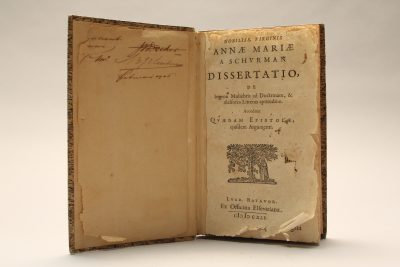
Commonly abbreviated into Dissertatio, this treatise on women’s education is her most renowned work. English editions translate the title into The Learned Maid, or Whether A Maid May Be a Scholar (trans. Barksdale, 1659), Whether the Study of Letters Is Fitting for a Christian Woman (trans. Irwin, 1998), and A Dissertation on the natural capacity of women for study and learning (trans. Clarke 2013). The work is composed of 14 theses advocating for women’s access to education. They serve three main points: 1) men and women are equally fit for learning; 2) the pursuit of knowledge allows one to elevate the “glory of God and the salvation of one’s soul” (van Schurman 1998, 26); and, 3) humans naturally want to learn, making learning an end onto itself, giving right to women to learning. She demonstrates how it is groundless for women to be barred from education, based on the premises that learning is a devotional activity and that women as members of the human species should seek to become more pious. The moderate nature of her argument may have been an important factor behind the wide acceptance of her treatise by male contemporaries (Irwin 1977, 48). Likewise, the moderate character of her argument is emphasized in her responses to the critiques by André Rivet, Andreas Colvius, Adolf Vorstius, Pierre Gassendi, Lady Moor, Simond D’ewes, and Frederick Spanheim. The work saw wide circulation across Europe, having been translated into French and English and also reprinted in Latin in 1641, 1646, and 1659. In addition to the content, another possible reason for the popularity of the work involves the prestige of the publisher, Elzevier, and the company’s trademark decorated cover. The famous Leiden-based company bound its books in highly decorated covers, which enticed many collectors to buy whatever Elzevier published. The original 1641 Leiden edition of Dissertatio was no exception. Van Beek (2010) suggests that the fanciful cover of Dissertatio played no small part to its wide ownership. She also suggests the same for van Schurman’s next publication, Opuscula (1648).
Editions:
|
|
|
|
|
|
|
|
|
|
|
|
|
|
|
|
|
|
|
|
|
|
|
|
|
|
|
|
|
|
|
|
|
|
|
|
|
|
|
|
|
|
|
|
|
|
|
|
|
|
|
|
|
|
|
|
References:
- Coffey, John. “Barksdale, Clement.” Oxford Dictionary of National Biography. Web. Published 23 September 2004. Web. Accessed 4 March, 2019. https://doi-org.proxy.lib.duke.edu/10.1093/ref:odnb/1425.
Opuscula Hebraea Graeca Latina et Gallica. Prosaica et Metrica
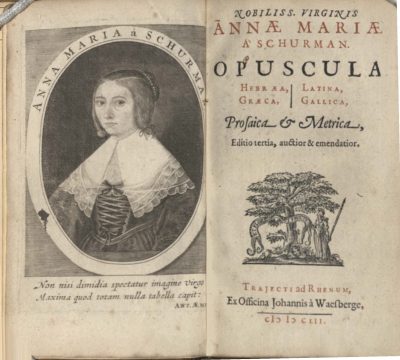
The publication of Opuscula began with Frederik Spanheim, professor of theology and rector at University of Leiden, repeatedly urging van Schurman to publish her scholarly letters, which she declined out of modesty every time. Then, in 1647, she responded more positively to him, which inspired him to publish an unauthorized edition of her letters in 1648. However, there, he had abridged some letters, removed all forms of address as well as postscripts, and eliminated the prologue and the epilogue of De Vitae Termino and of Dissertatio. When Spanheim passed away the following year, van Schurman published her own authorized and augmented edition of Opuscula in 1652, where she included those pages missing from the 1648 edition as well as additional letters, poems, and elegies.
This authorized collection of van Schurman’s works secured her international celebrity status as the “Tenth Muse” or “Star of Utrecht.” The text demonstrated the extent of her learning in Latin, Hebrew, Greek, French, and Dutch, as well as in several academic disciplines. Fortunately, many copies survive to this day, and are currently housed in major libraries across Europe and the United States. This may attest to its wide circulation. Schotel (1853) records that there have been four additional impressions of Opuscula, one from 1672 in Leiden and Herford, 1723 in Dresden, and 1749 in Leiden. However, Pieta van Beek (2010) notes that her research of two decades yielded no further evidence of those subsequent editions. Regardless, the work’s celebrity status is still remarkable, and we find mention of this work frequently in the Republic of Letters.
Van Beek argues that there are additional reasons for its popularity. Elzevier, the publisher of its first two iterations in 1648 and 1650, was one of the most prestigious publishers of the time, having many connections to book fairs across the continent and accompanying their products with an exquisitely designed cover (2010, 106). Many readers would have taken notice of Opuscula simply by its publisher. Moreover, in 1658 and again in 1678, Opuscula entered the list of banned books by the Roman Catholic Church, Index Librorum Prohibitorum, for reasons still confidential to this day. The ban, van Beek suggests, may have helped its popularity even more, as often happens with banned books.
In addition to the letters and the two scholarly works, Opuscula also includes a series of letters later referred to as “Epistola Theologica a Virginae Nobiliss Anna Schurmanna.” It records her contributions to the debate around the interpretation of 1 Corinthians 15:29, on the baptism for the dead. Lydius mentioned a separate publication of these letters, which remains untraceable today. It is his own translation of those letters that allowed it to be preserved and included in the 1641 edition of Dissertatio and all editions of Opuscula.
Exact table of contents for each editions of Opuscula can be found in the appendix of van Beek’s 1997 doctoral dissertation, cited here:
- Van Beek, Pieta. 1997. Klein Werk: De Opuscula Hebraea Graeca Latina et Gallica Prosaica et metrica van Anna Maria van Schurman (1607-1678). Ph.D. diss., University of Stellenbosch, South Africa.
All but the 1749 edition of Opuscula can also be found digitized and with full access on Google Books.
Editions:
|
|
|
|
|
|
|
|
|
|
|
|
|
|
|
|
|
|
|
|
|
|
|
|
|
|
|
|
|
|
|
|
|
|
|
See Current Location of Opuscula in this spreadsheet: Opuscula Locations
Eukleria seu Meliores Partis Electio (Eucleria, or Choosing the Better Part)
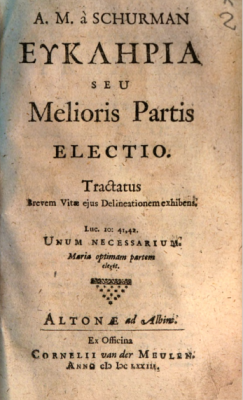
Two decades after van Schurman reached the heights of her scholarly fame through the popularity of Dissertatio and Opuscula, she presented a distinct view of herself in her autobiographical work entitled Eukleria. Van Schurman published this work after she had become a full-fledged follower of Jean de Labadie. In her autobiography, she reflects on her earlier life as an academic and describes the process behind her evolving attitudes towards education. The discontinuity in her stance on education prompted scholars to distinguish the early “Scholastic” van Schurman from the later “Pietist” one. But some scholars overemphasize this shift and overlook that in Eukleria, van Schurman reminds the audience of her deep commitment to piety that anchored her scholarly and artistic pursuits as a young woman.
Editions:
|
|
|
|
|
|
|
|
|
|
|
|
|
|
|
|
|
|
|
|
|
|
|
|
|
|
|
|
|
|
|
|
|
|
|
|
|
|
|
|
|
|
|
|
|
|
|
|
|
|
|
|
|
|
|
|
|
|
|
|
|
|
|
|
|
|
|
|
|
For image sources and permissions see our image gallery.
2.2 Extant Smaller Works
Anna Maria van Schurman authored numerous commentaries, poems, and scholarly letters that exhibit complex scholarship. Mostly written in the scholarly language of Latin, or in one of the ten other languages that testify to her linguistic virtuosity, these short works demonstrate a level of learning that caught the attention of the entire continent. She used her poetry as a means of commenting on current events, participated extensively in the rapidly expanding Republic of Letters (Pal 2012). What is remarkable, however, is not just the sheer volume of her output, but the depth and the expertise with which she addressed a wide variety of academic disciplines. Her contemporaries often wrote poems celebrating her erudition, and the news of her highly unusual intellect spread across the learned world. In an extremely rare occurrence, for instance, she was featured in university textbooks at Utrecht University (van Beek 2010, 246), despite the fact that women could not formally study at any university in Europe.
Many of her shorter works were preserved because they were included in Opuscula, or survived in the Nachlass of a colleague or correspondent. The outline below details prominent and longer works that are not treatises and that have been published by themselves at least once.
De Vitae Termino
The physician Johan van Beverwijck edited a volume of letters focused on two questions: 1) should humans attempt to prolong their life, if the duration of life had been determined by God; and, 2) what is the purpose of doctors if the time of death has been predetermined? Van Beverwijck called on several famous scholars to discuss these questions through correspondence; van Schurman was the only woman to be included in the discussion. In her contribution, she argued that God must also have planned any progress in medical science, so it is permissible to prolong a life medically. Indeed, since actual death is predetermined, perhaps patients were meant to be cured so that they could die at the proper time. In that way, doctors are “partners” with God. Her contributions appear 15 times in van Beverwijck’s volume. Her letters on this topic are also later included in all editions of Opuscula except for the 1749 Leipzig edition.
Editions:
| Title | Year | City and Publisher | Language | Citation |
| De Vitae Termino | 1639 | Brittenburg (near Leiden): Johannes le Maire | Latin | Van Schurman, Anna Maria. 1639. “De Vitae Termino”. In Epistolica quaestio de vitae termino, fatali an mobili? Cum doctorum responsis. Pars tertia, et ultima, nunc prima edita. Seorsim accedit […] Annae Mariae a Schurman de eodem argumento epistola, totius disputationis terminus […], edited by Johan van Beverwijck. Brittenburg: Johannes le Maire. |
| De Vitae Termino | 1644 | Rotterdam: Arnold Leers | Latin | Van Schurman, Anna Maria. 1644. “De Vitae Termino”. In Epistolica quaestiones cum doctorum responsis, edited by Johan van Beverwijck, 1-14. Rotterdam: Arnold Leers. |
| De Vitae Termino | 1665 | Dordrecht: Rudolph a Nuyssel | Latin | Van Schurman, Anna Maria. 1655. “De Vitae Termino”. In Epistolica quaestiones cum doctorum responsis, edited by Johan van Beverwijck, 1-14. Dordrecht: Rudolph a Nuyssel. |
| Paelsteen van den tijd onses levens | 1639 | Dordrecht: Jasper Gorissz | Dutch | Van Schurman, Anna Maria. 1639. Paelsteen van den tijd onses levens. Dordrecht: Jasper Gorissz. |
| Paelsteen van den tijd onses levens | 1639 | Amsterdam: Joost Broersz | Dutch | Van Schurman, Anna Maria. 1639. Paelsteen van den tijd onses levens. Amsterdam: Joost Broersz. |
| Paelsteen van den tijd onses levens | 1647 | Amsterdam: Joost Broersz | Dutch | Van Schurman, Anna Maria. 1647. Paelsteen van den tijd onses levens. Amsterdam: Joost Broersz. |
| Paelsteen | 1651 | Dordrecht: Jasper Gorissz | Dutch | Van Schurman, Anna Maria. 1651. “Paelsteen”. In Schat der ongesontheyt, 51-56. Dordrecht: Jasper Gorissz. |
| Der Marckstein vom Ziel und Zeit unseres Lebens | 1678 | Unknown: unknown | German | Van Schurman, Anna Maria. 1678. Der Marckstein vom Ziel und Zeit unseres Lebens, translated by S.W.Z.B. s.l.: s.n. |
| Geleerde Brieven van de Edele, Deugt- en Konstryke Juffrouw, Anna Maria van Schuurman; gewisselt met de Geleerde en Beroemde Heeren Samuel Rachelius, professor in de Rechten te Kiel en Johan van Beverwijck, Med. Doct. tot Dordrecht. | 1728 | Amsterdam: Johannes van Septeren | Dutch | Van Schurman, Anna Maria. 1728. Geleerde Brieven van de Edele, Deugt- en Konstryke Juffrouw, Anna Maria van Schuurman; gewisselt met de Geleerde en Beroemde Heeren Samuel Rachelius, professor in de Rechten te Kiel en Johan van Beverwijck, Med. Doct. tot Dordrecht. Amsterdam: Johannes van Septeren. |
| Lettres traduites du Hollandois par madame de Zoutelande | 1730 | Paris: Rebuffé | French | Van Schurman, Anna Maria. 1730. Lettres traduites du Hollandois par madame de Zoutelande. Paris: Rebuffé. |
Vraaghbrief, waerom de Heere Christus, daer hy ongeneselijcke Sieckten, soo met een Woordt, so met Aenraken genas, des Blindens oogen met Slick, en Speecksel gestreken heeft?
Loosely translated as “Question letter,” the Vraaghbrief is a published correspondence with Johan van Beverwijck on Jesus’s miraculous healing of the man born blind (John 9: 1-12). It is included in van Beverwijck’s “Aenhangsel van Brieven” (“attachment of letters”) appendix to the Wercken der genees-konste, bestaende in den Schat de gesontheyt, Schat der gesontheit en ongesontheit, as letter number four in their five-letter correspondence. In that same series of letters, letter number two is the above Paelsteen (Dutch translation of De Vitae Termino).
Editions:
| Title | Date | City and Publisher | Language | Citation |
| Vraeghbrief, waerom de Heere Christus, daer hy ongeneselijcke Sieckten, soo met een Woordt, so met Aenraken genas, des Blindens oogen met Slick, en Speecksel gestreken heeft? | 1642 | Amsterdam: J. Schipper | Dutch | Van Schurman, Anna Maria. 1642. “Vraeghbrief, waerom de Heere Christus, daer hy ongeneselijcke Sieckten, soo met een Woordt, so met Aenraken genas, des Blindens oogen met Slick, en Speecksel gestreken heeft?” In Schat der ongesontheit, Aenhangsel van Brieven, edited by Johan van Beverwijck, 121-124. Amsterdam: J. Schipper. |
| Vraeghbrief, waerom de Heere Christus, daer hy ongeneselijcke Sieckten, soo met een Woordt, so met Aenraken genas, des Blindens oogen met Slick, en Speecksel gestreken heeft? | 1680 | Amsterdam: J. Schipper | Dutch | Van Schurman, Anna Maria. 1680. “Vraeghbrief, waerom de Heere Christus, daer hy ongeneselijcke Sieckten, soo met een Woordt, so met Aenraken genas, des Blindens oogen met Slick, en Speecksel gestreken heeft?” In Schat der gesontheit en ongesontheit Part III, Aenhangsel van Brieven, edited by Johan van Beverwijck. Amsterdam: J. Schipper. |
| Lettres traduites du Hollandois par madame de Zoutelande | 1730 | Paris: Rebuffé | French | Van Schurman, Anna Maria. 1730. Lettres traduites du Hollandois par madame de Zoutelande. Paris: Rebuffé. |
Bedenckingen over de toekomst van Christi Koninkrijk
When van Schurman became increasingly disillusioned with the mainstream church later in her life, she expressed her religious views in her poetry. She wrote this religious didactic poem in Dutch about the future of the Church, the love between Christ and the soul, and the interpretation of Genesis 1-3. It originally circulated in manuscript form and was published later. The poem was also set to music, which was performed on September 15, 1668, in Mijdrecht at the home of the minister Van Almeloveen. This poem provides a look into her transition from the “early,” “Scholastic” van Schurman into the later “Pietist.” The poem is included in van Schurman’s Dutch translation of Jean de Labadie’s French text, Odes sacrées sur le Très-adorable et auguste Mystère du S. Sacrement de l’Autel [Sacred Odes…], Amiens, 1642. See also Van Schurman, 1992, Verbastert Christendom, edited by Pieta van Beek: 79-92.
Editions:
| Title | Date | City and Publisher | Language | Citation |
| Bedenckingen over de toekomste van Christi Koninkrijck | No date; manuscript form | No publisher | Dutch | Van Schurman, Anna Maria. N.d. “Bedenckingen over de toekomste van Christi Koninkrijck”. s.a. s.l. |
| Bedenkingen van A.M. van Schuurman over de toekomste van Christi Koningryk | 1675 | Amsterdam: Jacob van Velzen | Dutch | Labadie, Jean de. 1675. “Bedenkingen van A.M. van Schuurman over de toekomste van Christi Koningryk”. In Heylige Lof-sangen ter Eeren Gods, tot Heerlijkheid van Jesus Christus, en tot Vertroostinge en vreugde van syn Kerk, translated by Anna Maria van Schurman, 326-331. Amsterdam: Jacob van Velzen. |
| Bedenckingen van A.M. van Schurman over de Toekomste van Christi Coninkrijck | 1683 | Amsterdam: Jacob van de Velde | Dutch | Labadie, Jean de. 1683. “Bedenckingen van A.M. van Schurman over de Toekomste van Christi Coninkrijck”. In Heylige gesangen.Zijn achter bygevoegt de Bedenckingen van A.M. van Schurman over de Toekomste van Christi Coninkrijk, 394-400. Amsterdam: Jacob van de Velde. |
| Heylige gesangen. Zijn achter bygevoegt de Bedenckingen van A.M. van Schurman over de Toekomste van Christi Coninkrijk | 1683 | Amsterdam: Jacob van de Velde | Dutch | Labadie, Jean de. 1683. Heylige gesangen. Zijn achter bygevoegt de Bedenckingen van A.M. van Schurman over de Toekomste van Christi Coninkrijk. Amsterdam: Jacob van de Velde. |
| Bedenckingen over de toekomste van Christi Koninkrijck | 1826 | Dordrecht: unknown | Dutch | Van Schurman, Anna Maria. 1826. “Bedenckingen over de toekomste van Christi Koninkrijck”. In Mnemosyne xvi, 3-13. Dordrecht: s.n. |
Pensées d’A. M. de Schurman Sur la Reformation necessaire à present à l’Eglise de Christ.
Citation: Van Schurman, Anna Maria. 1669a. Pensées d’A. M. de Schurman Sur la Reformation necessaire à present à l’Eglise de Christ. Amsterdam: n.p.
In March 1669, she published this brief pamphlet that can be translated into “Thoughts of A. M. van Schurman on the Reformation necessary at present in the Church of Christ.” A work exhibiting her reasons for her later complete severance of ties with the mainstream church, she condemns the decline of the Church and contemporary morals for blasphemously imposing secular reason onto faith and belief (van Beek 2010, 215).
Sérieux avertissement et vive exhortation à toute sorte de Fidèles Réformés.
Citation: Samuel, Jean [pseudonym]. 1669b. Sérieux avertissement et vive exhortation à toute sorte de Fidèles Réformés. Amsterdam: Stephanus Molard.
The author of this 8-page pamphlet has typically been considered a mystery, but Larsen has recently argued (2018, 308) that the style and content closely mirror the Pensées and it should therefore be attributed to van Schurman (footnote 11). Included in the volume Jugement du Synode National des Eglises reformées des Pays-Bas tenu à Dordrecht l’an 1618 & 1619 (traduit du Latin en François), this “Serious Warning” on reformed faith is currently located at the Bibliothèque Sainte-Geneviève in Paris. Here, again, like the Pensées, she attacks the notion that faith is inferior to reason when used to justify claims, and argues that reason should not be the priority when accepting religious tenets.
Mysterium Magnum, Oder Grosses Geheimnüs das ist: Ein sehr herrliches und im heiligen Wort Gottes wohlgegründetes Bedencken Uber die Zukunft des Reichs Christi. Durch die hochgelehrte/in aller Welt beruffene und von Gott hochverleuchtete Jungfer Juffr. Anna Maria von Schurmann […].
Citation: Van Schurman, Anna Maria. 1699. Mysterium Magnum, Oder Grosses Geheimnüs das ist: Ein sehr herrliches und im heiligen Wort Gottes wohlgegründetes Bedencken Uber die Zukunft des Reichs Christi. Durch die hochgelehrte/in aller Welt beruffene und von Gott hochverleuchtete Jungfer Juffr. Anna Maria von Schurmann […]. Wesel-Duisburg und Franckfurt: Andreas Luppius.
This source is cited as van Schurman’s work in van Beek (1997 and 2010).
Uitbreiding over de drie eerste capittels van Genesis, Beneffens een vertoog van het geestelyk huwelyk van Christus met de gelovigen Beide in Zinrijke Digtmaat t’zamen gesteld, door wylen Juffer Anna Maria van Schuurman.
Citation: Van Schurman, Anna Maria. 1732. Uitbreiding over de drie eerste capittels van Genesis, Beneffens een vertoog van het geestelyk huwelyk van Christus met de gelovigen Beide in Zinrijke Digtmaat t’zamen gesteld, door wylen Juffer Anna Maria van Schuurman. Groningen: Jacob Sipkes.
One of her lesser known works, the Uitbreiding is a 944-line poem that is an exegesis of Genesis 1-3. It was written around 1660 but published posthumously in 1732. Just like the Bedenckingen above, van Schurman used the poetic medium as a platform for her theology.
See also the article by John L. Thompson, “Piety, Theology, Exegesis, and Tradition: Anna Maria van Schurman’s ‘Elaboration’ of Genesis 1-3 and its Relationship to the Commentary Tradition.” In Church and School in Early Modern Protestantism: Studies in Honor of Richard A. Muller on the Maturation of a Theological Tradition, edited by Jordan J. Ballor, David Sytsma, and Jason Zuidema, 613-28. Leiden: Brill, 2013.
For image sources and permissions see our image gallery.
2.3 Letters and Poems
The later, “Pietist” Van Schurman, regretting her days of academic pursuit and celebrity, burned many of her letters and poems, though this move may have been more motivated by her fear of becoming a cult figure. As a result, our chief primary sources for her correspondence and short works are her Opuscula and notable anthologies of her contemporaries, such as that of van Beverwijk. Yet, a remarkable inventory of her letters was published in Early Modern Letters Online by Samantha Sint Nicolaas that catalogues 239 surviving letters. This source draws heavily from Pieta van Beek’s continuing work of uncovering van Schurman’s writings, which she intermittently announces through her website as a series entitled “Schurmanniana.” Below are other sources that contain van Schurman’s letters and poems.
For image sources and permissions see our image gallery.
3. Secondary Sources Guide
Despite her prominence during her lifetime, scholarship discussing van Schurman’s life and work has waxed and waned over the years. After her death, the earliest reappearance of her name was in 1715 when Pierre Yvon (1646–1707), a fellow Labadist, discussed her influence in the Labadist community in a short biography of Jean de Labadie—this source was translated in part by Joyce Irwin in the 20th century (1979). Subsequent biographies (Schotel 1853, Tschackert 1876, Birch 1909, Douma 1924) of van Schurman have provided important discussions of archival material, and Pieta van Beek and Joyce Irwin led a vigorous resurgence of interest in her in the 1990s.
The following reference list is by no means exhaustive: the literature on van Schurman is vast, as she is a figure of interest in fields including art history, theology, European history, material culture, literature, education, and philosophy. This ongoing list focuses primarily on English-language works on her life and studies, but also includes major non-English works that significantly advanced the scholarship on van Schurman.
More extensive bibliographies, especially with Dutch and German sources, can be found in the biographies of Pieta van Beek (2010) and Anne Larsen (2016).
For an historical overview of secondary literature on van Schurman, please see this listing from Pieta van Beek’s website, http://annamariavanschurman.org/publications/publications-on-anna-maria-van-schurman-by-others/
For commentaries on select sources, please see Bo Karen Lee and Anne Larsen’s annotated bibliography. The organization of this secondary sources guide has been inspired by this entry:
Lee, Bo Karen, and Anne Larsen. April 2019. “Anna Maria van Schurman.” Oxford Bibliographies, Renaissance and Reformation. https://www.oxfordbibliographies.com/view/document/obo-9780195399301/obo-9780195399301-0399.xml.
For image sources and permissions see our image gallery.
3.1 Select Secondary Sources
Biographies and Overview:
- Andersen, Jenny. 2003. “Anna Maria van Schurman.” In Reading Early Women: An Anthology of Texts in Manuscript and Print, 1500–1700, edited by Helen Ostovich and Elizabeth Sauer. London: Routledge.
- Atherton, Margaret. 1994. Women Philosophers of the Early Modern Period. Indianapolis: Hackett Publishing Company.
- Baar, Mirjam de, Machteld Löwensteyn, Marit Monteiro, and A. Agens Sneller, eds. 1996. Choosing the Better Part: Anna Maria van Schurman (1607–1678), translated by Lynne Richards from Een uitzonderlijk geleerde vrouw (Zutphen: Walberg Press, 1992). Dordrecht: Kluwer Academic.
- Birch, Una (a.k.a. Pope-Hennessy, Una). 1909. Anna Maria van Schurman: Artist, Scholar, Saint. New York: Longmans.
- Brandes, Ute. 1998. “Anna Maria van Schurman (Germany/The Netherlands).” In Women Writers in German-Speaking Countries: a Bio-Bibliographical Critical Sourcebook, edited by Elizabeth G. Ametsbichler and Elke P. Frederiksen. Westport, CN: Greenwood Press.
- Brouwer, Marjan. 2007. Vrouw van de wereld: Het leven van Anna Maria van Schurman. Franeker: Museum Martena.
- Douma, Anna M. H. 1924. “Anna Maria van Schurman en de Studie der Vrouw.” Ph.D. diss., University of Amsterdam.
- Dykeman, Therese Boos. 1999. The Neglected Canon: Nine Women Philosophers, first to the twentieth century. Dordrecht; Boston: Kluwer Academic.
- Ghijsen, H. C. M. 1926. “Anna Maria van Schurman, 1607-1678.” De Gids 90(1): 380–402.
- —. 1926. “Anna Maria van Schurman, 1607-1678.” De Gids 90(2): 105–128
- Irwin, Joyce. 1979. Womanhood in Radical Protestantism, 1525–1675. New York: Edwin Mellen.
- Larsen, Anne. 2016. Anna Maria van Schurman, ‘the Star of Utrecht’: the educational vision and reception of savante. Abingdon, Oxon: Routledge.
- Moore, Cornelia Niekus. 1990. “Anna Maria van Schurman.” Canadian Journal of Netherlandic Studies 11: 25–32.
- Nicéron, Jean-Pierre. 1736. Mémoires pour servir l’histoire des hommes illustres dans la République des Lettres: Avec un catalogue raisonné de leurs ouvrages. Vol. 33. Paris: Briasson.
- O’Neill, Eileen. 1998. “Anna Maria van Schurman.” Routledge Encyclopedia of Philosophy 10(8), edited by Edward Craig: 558.
- Pal, Carol. 2012. Republic of Women: Rethinking the Republic of Letters in the Seventeenth Century. Cambridge: Cambridge University Press.
- Rang, Brita. 1996. “‘An Exceptional Mind’: The Learned Anna Maria van Schurman.” In Choosing the Better Part: Anna Maria van Schurman, 1607–1678, edited by Mirjam de Baar, Machteld Löwensteyn, Marit Monteiro, and A. Agnes Sneller, 23–42. Dordrecht; Boston; London: Kluwer Academic Publishers.
- Schotel, G. D. J. 1853. Anna Maria van Schurman. ‘s-Hertogenbosch, Netherland: G. Muller.
- Spang, Michael. 2009. Wenn sie ein Mann wäre. Leben und Werk der Anna Maria van Schurman, 1607–1678. Darmstadt: WBG.
- Trudeau, Lawrence, and Thomas Schoenberg. 2012. “Anna Maria van Schurman, 1607–1678: German-Born Dutch Poet, Philosopher, Theologian, Artist, and Linguist.” In Literature Criticism from 1400–1800, edited by Lawrence Trudeau and Thomas Schoenberg. Detroit: Gale.
- Tschackert, Paul. 1876. Anna Maria von Schürmann, der Stern von Utrecht, die Jüngerin Labadie’s ein Bild aus der Kulturgeschichte des 17. Jahrhunderts. Gotha, Germany: Vortrag.
- Van Beek, Pieta. 2010. The First Female University Student: A. M. van Schurman. Utrecht: digitur.
- —. 2013. “Anna Maria van Schurman.” In The Oxford Guide to the Historical Reception of Augustine, edited by Willemien Otten and Karla Pollmann. Oxford: Oxford University Press.
- —. 2016. Het Wereldwonder van Utrechts Academie’ : Naam & Faam van Anna Maria van Schurman (1636-2016) [The Wonder of Utrecht Academy: Name & Fame of Anna Maria van Schurman (1636-2016)]. Ridderkirk, The Netherlands: Provily Pers.
- Van Schurman, Anna Maria. 1998. Whether a Christian Woman Should Be Educated and Other Writings from Her Intellectual Circle, edited and translated by Joyce L. Irwin. Chicago: University of Chicago Press.
- Yvon, Pierre. 1715. “Abregé sincere de la vie & de la Conduite & des vrais sentimens de feu Mr. De Labadie.” In Forsetzungen und Erläuterungen, Unpartheyische Kirchen- und Ketzerhistorie, edited by Gottfried Arnold, 1234–1270. Frankfurt: Thomas Fritsch. Reprints: Kürzliche und aufrichtige Vorstellung…, 984–1029 (Schaffhausen: 1741); Oprecht verhael van het leven… (Amsterdam, 1754).
Theology and Philosophy:
- Baar, Mirjam de. 1987. “En onder’t hennerot het haantje zoekt te blijven: De Betrokkenheid van vrouwen bij het huisgezin van Jean de Labadie, 1669–1732.” Jaarboek voor Vrouwengeschiedenis 8: 11–43.
- —. 1996. “‘Now as for the Faint Rumours of Fame Attached to My Name…’: The Eukleria as Autobiography.” In Choosing the Better Part: Anna Maria van Schurman, 1607–1678, edited by Mirjam de Baar, Machteld Löwensteyn, Marit Monteiro, and A. Agnes Sneller, 87–102. Dordrecht; Boston; London: Kluwer Academic Publishers.
- —. 2003. “Anna Maria van Schurman (1607–78).” In The Dictionary of Seventeenth- and Eighteenth-Century Dutch Philosophers 2, edited by Wiep van Bunge, Henri Krop, Bart Leeuwenburgh, et al. Bristol, UK: Thoemmes.
- —. 2011. “Gender, Genre and Authority in Seventeenth-Century Religious Writing: Anna Maria van Schurman and Antoinette Bourignon as Contrasting Examples.” In Ein Platz für sich selbst: Schreibende Frauen und ihre Lebenswelten, 1450–1700, edited by A. Bollmann. Frankfurt: Peter Lang.
- Becker-Cantarino, Barbara. 1996. “Erwäahlung des bessern Teils: Zur Problematik von Selbstbild und Fremild in Anna Maria van Schurman’s ‘Eukleria.’” In Autobiographien von Frauen: Beiträge zu ihrer Geschichte, edited by Magdalene Heuser. Tübingen, Germany: Niemeyer.
- Bloem, Jeannette. “The Shaping of a ‘Beautiful’ Soul: The Critical Life of Anna Maria van Schurman.” In Feminism and the Final Foucault, edited by Dianna Taylor and Karen Vintges. Urbana: University of Illinois Press, 2004.
- Demers, Patricia. 2015. “Anna Maria van Schurman: The Arts of Argumentation and Self-Portraiture.” In Acta Conventus Neo-Latini Monasteriensis: Proceedings of the Fifteenth International Congress of Neo-Latin Studies. Münster, August 5–11, 2012. Edited by Astrid Steiner-Weber and Karl A. E. Enenkel, 192–292. Leiden, The Netherlands: Brill.
- Irwin, Joyce. 1977. “Anna Maria van Schurman: From Feminism to Pietism.” Church History 46: 48–62.
- —. 1980. “Anna Maria van Schurman: The Star of Utrecht.” In Female Scholars: A Tradition of Learned Women before 1800, edited by J. R. Brink, 68–85. Montreal: Eden Press Women’s Publications.
- —. 1980. “From Orthodoxy to Pietism: The Self-Representation of Anna Maria van Schurman.” Covenant Quarterly 38: 3–11.
- —. 1991. “Anna Maria van Schurman and Antoinette Bourignon: Contrasting Examples of Seventeenth-Century Pietism.” Church History 60(3): 301–315.
- —. 1996. “Anna Maria van Schurman: Eine Gelehrte zwischen Humanismus und Pietismus.” In Geschichte der Mädchen- und Frauenbildung, edited by Elke Kleinau, 309–324. Frankfurt: Campus-Verlag.
- Larsen, Anne. 2014. “Anna Maria van Schurman and Descartes.” Paper presented at the RSA Annual Meeting in New York, NY, Hilton New York, on December 10, 2014. http://citation.allacademic.com/meta/p676676_index.html.
- —. 2018. “Religious Alterity: Anna Maria van Schurman and Jean de Labadie.” French Forum 43(2): 301–317.
- Lee, Bo Karen. 2007. “‘I Wish To Be Nothing’: The Role of Self-Denial in the Mystical Theology of Anna Maria van Schurman.” In Women, Gender and Radical Religion in Early Modern Europe, edited by Sylvia Brown, 189–216. Leiden: Brill.
- —. 2014. Sacrifice and Delight in the Mystical Theologies of Anna Maria van Schurman and Madame Jeanne Guyon. Studies in Spirituality and Theology. South Bend, IN: Notre Dame University Press.
- Linde, S. van der. 1978. “Anna Maria van Schurman en haar Eucleria.” Theologia Reformata 21: 117–145.
- Malena, Adelisa, and Xenia von Tippelskirch. 2016. “Le genre des ‘âmes élues’: Labadie et ses lectrices, entre attaques polémiques et héritage spirituel.” In Lire Jean de Labadie (1610–1674): Fondation et affranchissement, edited by Pierre Antoine Fabre, Nicolas Fernerod, Sophie Houdard, and Maria-Cristina Pitassi, 231–261. Paris: Classiques Garnier.
- O’Neill, Eileen. 1999. “Women Cartesians, Feminine Philosophy, and Historical Exclusion.” In Feminist Interpretations Rene Descartes, edited by Susan Bordo. University Park: Penn State Press.
- Peacock, Martha Moffitt. 2014. “The Inner Cause and the Better Choice: Anna Maria van Schurman, Self-Fashioning, and the Attraction of the Labadist Religion.” In Mental Health, Spirituality, and Religion in the Middle Ages and Early Modern Age, edited by Albrecht Classen. Berlin; Boston: de Gruyter.
- Prozesky, Martin H. 1977. “The Emergence of Dutch Pietism.” Journal of Ecclesiastical History 28.1: 29–37.
- Roothaan, Angela. 1996. “Anna Maria van Schurman’s ‘Reformation’ of Philosophy: Philosophy and Science in the Seventeenth Century.” In Choosing the Better Part: Anna Maria van Schurman, 1607–1678, edited by Mirjam de Baar, Machteld Löwensteyn, Marit Monteiro, and A. Agnes Sneller, 103–116. Dordrecht; Boston; London: Kluwer Academic Publishers.
- Saxby, Trevor J. 1987. The Quest for the New Jerusalem: Jean de Labadie and the Labadists. Dordrecht, The Netherlands: Martinus Nijhoff.
- Scheenstra, Erica. 1996. “On Anna Maria van Schurman’s ‘Right Choice’.” In Choosing the Better Part: Anna Maria van Schurman, 1607–1678, edited by Mirjam de Baar, Machteld Löwensteyn, Marit Monteiro, and A. Agnes Sneller, 117–132. Dordrecht; Boston; London: Kluwer Academic Publishers.
- Thompson, John L. 2013. “Piety, Theology, Exegesis, and Tradition: Anna Maria van Schurman’s ‘Elaboration’ of Genesis 1–3 and Its Relationship to the Commentary Tradition.” In Church and School in Early Modern Protestantism: Studies in Honor of Richard A. Muller on the Maturation of a Theological Tradition, edited by Jordan J. Ballor, David S. Sytsma, and Jason Zuidema, 613–628. Leiden: Brill.
- Van Beek, Pieta. 1996. “‘O Utrecht, Lieve Stad…’: Poems in Dutch by Anna Maria van Schurman.” In Choosing the Better Part: Anna Maria van Schurman, 1607–1678, edited by Mirjam de Baar, Machteld Löwensteyn, Marit Monteiro, and A. Agnes Sneller, 69–86. Dordrecht; Boston; London: Kluwer Academic Publishers.
- —. 2004. “Ardens martyrii desiderium: On the Martyrdom of Anna Maria van Schurman, 1607–1678.” In The Low Countries as a Crossroads of Religious Beliefs, edited by Arie-Jan Gelderblom, Jan de Jong, and Marc van Vaeck, 247–266. Intersections 3. Leiden: Brill.
Philosophy of Education:
- Bulckaert, Barbara. 1997. “L’éducation de la femme dans la correspondance d’Anna Maria van Schurman (1607–1678) et André Rivet (1572–1651).” In La femme lettrée à la Renaissance: Actes du colloque international Bruxelles, 27–29 mars 1996, edited by Michel Bastiaensen, 197–209. Brussels: Peeters.
- —. 2010. “Self-Tuition and the Intellectual Achievement of Early Modern Women: Anna Maria van Schurman (1607–1678).” In Women, Education, and Agency, 1600–2000, edited by Jean Spence, Sarah Aiston, and Maureen M. Meikle, 9–26. New York: Routledge.
- Clarke, Desmond. 2013 “Anna Maria van Schurman and Women’s Education.” In Penser au féminin au XVIIe siècle: Revue philosophique de la France et de l’étranger, edited by Marie-Frédérique Pellegrin, 347–360. Paris: Presses Universitaires de France.
- Dorlin, Elsa. 2000. L’évidence de l’égalité des sexes: Une philosophie oubliée du XVIIe siècle. Paris: L’Harmattan.
- Duran, Jane. 2014. “Christianity and Women’s Education: Anna Maria van Schurman and Mary Astell.” Philosophy and Theology: Marquette University Quarterly 26(1): 3–18.
- Eck, Caroline van. 1996. “The First Dutch Feminist Tract?: Anna Maria van Schurman’s Discussion of Women’s Aptitude for the Study of Arts and Sciences.” In Choosing the Better Part, edited by Mirjam de Baar et al., 43–54. Dordrecht; Boston: Kluwer Academic.
- Elk, Martine van. 2017. “Education and Reputation: Anna Maria van Schurman and Margaret Cavendish.” In Early Modern Women’s Writing: Domesticity, Privacy, and the Public Sphere in England and the Dutch Republic. Early Modern Literature in History. London: Palgrave Macmillan.
- Findlen, Paula. 2002. “Ideas in the Mind: Gender and Knowledge in the Seventeenth Century.” Hypatia 17(1): 183–196.
- Irwin, Joyce. 1989. “Anna Maria van Schurman: The Learned Maid of Utrecht.” In Women Writers of the Seventeenth Century, edited by Katharina M. Wilson and Frank J. Warnke, 164–185. Athens, GA: University of Georgia Press.
- Moore, Cornelia Niekus. 1994. “Anna Maria van Schurman.” In Women Writing in Dutch, edited by Kristiaan Aercke, 185–230. New York: Garland.
- Teague, Francis, and Margaret J. M. Ezell, eds. 2016. Bathsua Makin and Mary More, with a Reply to More by Robert Whitehall: Educating English Daughters; Late Seventeenth-Century Debates. Tempe: Arizona Center for Medieval and Renaissance Studies.
- Uckelman, Sara L. 2018. “Bathsua Makin and Anna Maria van Schurman: Education and the Metaphysics of Being a Woman.” In Early Modern Women on Metaphysics, edited by Emily Thomas, 95–110. Cambridge, UK: Cambridge University Press.
- Wyles, Rosie. 2016. “Ménage’s Learned Ladies: Anne Dacier (1647–1720) and Anna Maria van Schurman (1607–1678).” In Women Classical Scholars: Unsealing the Fountain from the Renaissance to Jacqueline de Romilly, edited by Rosie Wyles and Edith Hall, 61–77. Oxford: Oxford University Press.
Languages:
- Goldman, Shalom. 1999. “’Spiritual Feminism’ and Christian Hebraism: Women and the Study of Hebrew in Seventeenth Century Europe.” Hebrew Studies 40: 153–163.
- Stevenson, Jane. 2005. Women Latin Poets: Language, Gender, and Authority, from Antiquity to Eighteenth Century, 336–367. Oxford: Oxford University Press.
- Van Beek, Pieta. 1995. “‘One Tongue is Enough for a Woman’: The Correspondence in Greek between Anna Maria van Schurman (1607–1678) and Bathsua Makin (1600–167?).” Dutch Crossing 19(1): 24-48.
- —. 2002. “‘Alpha Virginum’: Anna Maria van Schurman (1607–1678).” In Women Writing Latin from Roman Antiquity to Early Modern Europe 3, edited by Laurie J. Churchill, Phyllis R. Brown, and Jane E. Jeffrey, 247–265. New York: Routledge.
- —. 2009. “‘Liever een maagd dan een weduwe’: twee Latijnse gedichten op naam van Anna Maria van Schurman (1607-1678).” (“Rather a virgin than a widow”: two Latin erotic poems attributed to Anna Maria van Schurman (1607–1678)). Tydskrif vir Geesteswetenskappe 49(2): 333-349.
- —. 2010. “Schurman, Anna Maria van.” In Encyclopaedia Aethiopica 4, edited by Siegbert Uhlig in cooperation with Alessandro Bausi, 578–579. Wiesbaden, Germany: Harrassowitz Verlag.
- —. 2016. “Anna Maria van Schurman.” In Christian-Muslim Relations: A Bibliographical History 8, edited by David Thomas and John Chesworth, 596–602. Leiden, The Netherlands: Brill.
- —. 2018. “ὩΣ ῬΌΔΟΝ ἘΝ ἈΚ΄ΑΝΘΑΙΣ ‘As a Rose among the Thorns’: Anna Maria van Schurman and Her Correspondences in Greek.” In Hellenostephanos: Humanist Greek in Early Modern Europe, edited by Janika Päll and Ivo Volt, 410–433. Tartu, Finland: University Library of Tartu.
Artistic Accomplishments:
- Ezell, Margaret J.M. 2012. “Seventeenth-Century Female Author Portraits, Or, The Company She Keeps.” Zeitschrift fur Anglistik und Amerikanistik 60(1): 31–45.
- ffolliott, Sheila. 2013. “Early Modern Women Artists.” In The Ashgate Research Companion to Women and Gender in Early Modern Europe, edited by Allyson M. Poska, Jane Couchman, and Katherine A. McIver, 423–443. Farnham, UK: Ashgate.
- Goodman, Elise. 2008. The Cultivated Woman: Portraiture in Seventeenth-Century France. Tübingen : Narr.
- Harris, Ann Sutherland and Linda Nochlin. 1979. Women Artists: 1550–1950. Los Angelos: Los Angelos County Museum of Art.
- Honig, Elizabeth Alice. 2001-2002. “The Art of Being ‘Artistic’: Dutch Women’s Creative Practices in the 17th Century.” Woman’s Art Journal 22(2): 31–39.
- Van der Stighelen, Katlijne. 1987a. Anna Maria van Schurman (1607–1678) of “Hoe hooge date en maeght kan in de konsten stijgen.” Louvain, Belgium: Symbolae Facultatis Litterarum et Philosophiae Lovaniensis.
- —. 1987b. “Constantijn Huygens en Anna Maria van Schurman,” De Zeventiende Eeuw 3: 138–48.
- —. 1996. “‘Et ses artistes mains . . .’: The Art of Anna Maria van Schurman.” In Choosing the Better Part: Anna Maria van Schurman, 1607–1678, edited by Mirjam de Baar, Machteld. Löwensteyn, Marit Monteiro, and A. Agnes Sneller, 55–68. Dordrecht; Boston; London: Kluwer Academic Publishers.
- Van der Stighelen, Katlijne, and Jeanine de Landtsheer. 2010. “Een suer-soete Maeghd voor Constantijn Huygens, Anna Maria van Schurman (1607–1678).” In Vrouwen rondom Huygens, edited by Els Kloek, Frans Blom, and Ad Leerintveld, 149–202. Hilversum, The Netherlands: Verloren.
- Wheelock, Arthur K., Jr. 2012. “Nothing Gray about Her: Cornelis Jonson van Ceulen’s Grisaille of Anna Maria van Schurman.” In Face Book: Studies on Dutch and Flemish Portraiture of the 16th–18th Centuries; Liber Amicorum Presented to Rudolf E. O. Ekkart on the Occasion of His 65th Birthday, edited by Edwin Buijsen, Charles Dumas, and Volker Manuth, 325–330. Leiden, The Netherlands: Primavera Pers.
Connections:
- Baar, Mirjam de. 1994. “Trangressing Gender Codes: Anna Maria van Schurman and Antoinette Bourignon as Contrasting Examples.” In Women of the Golden Age: an International Debate on Women in Seventeenth-Century Holland, England and Italy, edited by Marijke Huisman, Els Kloek, and Nicole Teeuwen. Hilversum: Verloren.
- —. 2004. “‘God has chosen you to be a crown of glory for all women!’ The International Network of Learned Women Surrounding Anna Maria van Schurman.” In “I Have Heard About You”: Foreign Women’s Writing Crossing the Dutch Border: From Sappho to Selma Lagerlöf, edited by Suzanna van Dijk and Mirjam de Baar, and translated by Jo Nesbitt. Hilversum: Verloren.
- Baar, Mirjam de, and Brita Rang. 1996. “Anna Maria van Schurman: A Historical Survey of Her Reception since the Seventeenth Century.” In Choosing the Better Part: Anna Maria van Schurman, 1607–1678, edited by Mirjam de Baar, Machteld Löwensteyn, Marit Monteiro, and A. Agnes Sneller, 1–21. Dordrecht; Boston; London: Kluwer Academic Publishers.
- Gim, Lisa. 2007. “Representing the ‘Phoenix Queen’: Elizabeth I in Writings by Anna Maria van Schurman and Anne Bradstreet.” In Resurrecting Elizabeth I in Seventeenth-Century England, edited by Katherine Conway and Elizabeth Hageman. Madison: Fairleigh Dickinson University Press.
- Larsen, Anne. 2005. “The French Reception of Anna Maria van Schurman’s Letters on Women’s Education.” In Women’s Letters Across Europe, 1400–1700: Form and Persuasion, edited by Jane Couchman and Ann Crabb. Aldershot: Ashgate.
- —. 2008. “A Women’s Republic of Letters: Anna Maria van Schurman, Marie de Gournay, and Female Self-Representation in Relation to the Public Sphere.” Early Modern Women: An Interdisciplinary Journal 3: 105–126.
- Norbrook, David. 2003. “Autonomy and the Republic of Letters: Michèle Le Dœuff, Anna Maria van Schurman, and the History of Women Intellectuals.” Australian Journal of French Studies 40: 275–287.
- —. 2004. “Women, the Republic of Letters, and the Public Sphere in the Mid-Seventeenth Century.” Criticism 46(2): 223–240.
- O’Neill, Eileen. 2005. “Early Modern Women Philosophers and the History of Philosophy.” Hypatia 20(3): 185–197.
- Pal, Carol. 2009. “Forming familles d’alliance: Intellectual Kinship in the Republic of Letters.” In Early Modern Women and Transnational Communities of Letters, edited by Julie D. Campbell and Anne R. Larsen, 251–280. Farnham, UK: Ashgate.
- —. 2012. Republic of Women: Rethinking the Republic of Letters in the Seventeenth Century. Cambridge, UK: Cambridge University Press.
- Smet, Ingrid A. R. de. 1997. “‘In the Name of the Father’: Feminist Voices in the Republic of Letters (A. Tarabotti, A. M. van Schurman, and M. de Gournay).” In La Femme lettrée à la Renaissance: Actes du colloque international Bruxelles, 27–29 mars 1996, edited by Michel Bastiaensen, 177–196. Brussels: Pieters.
- Sneller, A. Agnes. 1996. “‘If She Had Been a Man…’: Anna Maria van Schurman in the social and literary life of her age.” In Choosing the Better Part: Anna Maria van Schurman, 1607–1678, edited by Mirjam de Baar, Machteld Löwensteyn, Marit Monteiro, and A. Agnes Sneller, 133–149. Dordrecht; Boston; London: Kluwer Academic Publishers.
- Van Beek, Pieta. 1995. “One Tongue Is Enough for a Woman: The Correspondence in Greek between Anna Maria van Schurman and Bathsua Makin.” Dutch Crossing 19: 24–48.
- —. 1996. “Een Vrouwenrepubliek der Letteren? Anna Maria van Schurman (1607–1678) en haar netwerk van geleerde vrouwen.” Tydskrif vir Nederlands en Afrikaans 3: 36–49.
- —. 2012. “‘Habent sua fata libelli’: The Adventures and Influence of Anna Maria van Schurman’s Work in Scandinavia.” In Acta Conventus Neo-Latini Upsaliensis: Proceedings of the Fourteenth International Congress of Neo-Latin Studies (Uppsala 2009). 2 vols., edited by Astrid Steiner-Weber, 199–209. Leiden: Brill.
- —. 2014a. “On God”: An Unknown Florilegium with Sayings about God by Anna Maria van Schurman (ca. 1625), translated by Dineke Ehlers. Schurmanniana 1. Ridderkerk, The Netherlands: Provily Pers.
- —. 2014b. “Uw lieftalige brief”: Een onbekende brief van Anna Maria van Schurman aan Johannes Vollenhove (1668). Schurmanniana 2. Ridderkerk, The Netherlands: Provily Pers.
- —. 2015a. “Verslonden door zijn liefde”: Een onbekende brief van Anna Maria van Schurman aan Petrus Montanus (1669). Schurmanniana 3. Ridderkerk, The Netherlands: Provily Pers.
- —. 2015b. “Herrezen uit de as”: Verbrande lofgeschriften van Rotger zum Bergen voor Anna Maria van Schurman, 1649–1655. Schurmanniana 4. Ridderkerk, The Netherlands: Provily Pers.
- —. 2016. “Ex Libris”: De bibliotheek van Anna Maria van Schurman en de catalogi van de Labadistenbibliotheek. Schurmanniana 5. Ridderkerk, The Netherlands: Provily Pers.
- Voisine, Jacques. 1972. “Un astre éclipsé: Anna Maria van Schurman, 1607–1678.” Études Germaniques 27: 501–531.
- Yvon, Pierre. 1715. “Abregé sincere de la vie & de la Conduite & des vrais sentimens de feu Mr. De Labadie.” In Forsetzungen und Erläuterungen, Unpartheyische Kirchen- und Ketzerhistorie, edited by Gottfried Arnold, 1234–1270. Frankfurt: Thomas Fritsch.
For image sources and permissions see our image gallery.
4. Philosophy & Teaching
Van Schurman’s principal philosophical work, Dissertatio, is a fascinating text. It represents a mélange of two philosophical worlds. On the one hand, it is what we might call a conservative text: it employs the standard style of the Scholastic disputation, presenting a thesis in various forms, arguing for it, registering objections to it, then answering those objections. It is a style that most of the moderns—from Galileo to Descartes to Leibniz to Newton and so on—would have recognized immediately from their educations, but chose to reject for the most part in their own writing. On the other hand, van Schurman uses this standard style to argue for a thesis that was highly controversial and certainly not conservative at the time, viz., that the study of the arts and sciences is appropriate for a Christian woman. It was controversial for various reasons, not least because none of the colleges or universities in Europe at that time—the very institutions where the Scholastic style employed by van Schurman was taught—admitted women. It must be said that the great “moderns” who helped to end the reign of Scholastic thought during the 17th century were normally silent on the question of women’s education; that is, their enormous philosophical challenge to the reigning orthodoxy in education and philosophy stopped at gender’s door. And as we have seen with van Schurman’s correspondence with her friend Rivet, when the subject was broached, many male figures were simply unconvinced that women in general ought to be afforded an education. For all of these reasons, van Schurman knew that she was facing an uphill battle.
Dissertatio is a short but extremely dense text, so we can provide only an overview of its main arguments here. The principal focus of the text is this question: is the study of letters (studium Litterarum) appropriate for a Christian woman? Following the Scholastic method that would have been familiar with her educated readers, van Schurman regards the study of letters, or education, as the “predicate” of the question, and the Christian woman as the “subject.” In an echo of her previous dispute with Rivet, she is willing to “limit” the subject in question to those women who are of reasonable intelligence and who have some free time for study. With respect to the predicate, however, she makes it clear that she intends letters to cover all of the following: logic, rhetoric, grammar, physics, metaphysics, history, languages (especially Greek and Hebrew), mathematics (which includes music), poetry, painting, and even law and political theory. We easily recognize this list as forming what we now call a liberal arts education. With the question now clearly formulated and properly explicated, van Schurman makes a long series of arguments to convince her reader that the answer to her guiding question is yes.
One of her arguments focusing on the “subject” of the question is as follows: arts and sciences are suitable for anyone who has the capacity to learn them, and we know that women have that capacity because women are human beings, and therefore have reason. Moreover, we know about that capacity because there are examples of women who have actually learned the arts and sciences (Clarke 2013, 82). Her textual mélange is evident in this argument. Van Schurman draws on numerous classical authorities—she cites Plato, Aristotle, Ovid, St. Paul, Plutarch, etc.—for their views on the capacity of human beings, as rational creatures, to understand the principles of the arts and sciences. This is a standard maneuver. However, van Schurman couples it with what was a radical move at that time: she adds explicitly that women are human, and that women therefore have the capacity to use reason in the way that so many classical authors have described. Of course, she knew perfectly well that with few exceptions, when classical (not to mention modern!) authors discussed humanity, or man, they were ignoring women altogether. By using their authority, but then bringing out an implication that they did not intend, van Schurman cleverly places her reader in a bind. Surely, the reader would not wish to disagree with all of these authorities by saying that human beings are not rational creatures with the capacity to learn the principles of the arts and sciences. So the only way out is to adopt the equally problematic path of trying to argue that women are somehow not human beings. This enables her to benefit from a consequence of the fact that classical authors did not explicitly make such a problematic claim; instead, when talking of man, they simply ignored women. Van Schurman shows us the consequences of not ignoring them. Many scholars today disagree about the use of the term ‘feminist’ for an author writing in van Schurman’s day, long before the feminism of the 19th and 20th centuries had developed. What one can safely say is that van Schurman’s Dissertatio uses a clever maneuver that many feminists would employ to much effect many years later (see, e.g., the now classic account in Okin 1979, 5). But van Schurman is not a 20th century author. For instance, she also provides arguments concerning the “predicate” in the question. She argues that education will provide women with a greater reverence for God because the study of arts and sciences reveals “God and his works” to the student (Clarke 2013, 86-87). That kind of view would have been common at this time.
Van Schurman was well aware that her views were destined to be highly controversial, and the Scholastic method she employed in Dissertatio enabled her to explicitly consider various objections that her readers might present. Some might object, she wrote, that women’s “natural ability is weaker” than that of men, so education is not appropriate for them. She replies that although women might not be comparable to “the most excellent men,” nonetheless many women would clearly benefit from education. She leaves it to her reader to ponder whether this concession was done for practical purposes, or reflected her deeply held views. Another objection might be that since there are no colleges or educational institutions that admit women, it isn’t appropriate for them to receive an education. Her reply is rather practical: it may be true that at this time, no such institutions exist, but women can receive an education from tutors. Her conclusion in the text overall is that women should be encouraged to receive an education in the arts and sciences, they should study the best arguments that have been made, and they should also learn about the illustrious women who have come before them. It hardly needs repeating that van Schurman herself was one of those women.
Van Schurman’s perspective and arguments in Dissertatio increased her fame and circulated widely in early modern European intellectual circles. To take just one prominent example, the entry on “Femme” (“Woman”) in the Encyclopedia of Diderot and D’Alembert, perhaps the most famous text of the entire Enlightenment, discusses Dissertatio:
“A. Maria van Schurman [13] has posed the following problem: is the study of literature suitable to a Christian woman? She responds in the affirmative; she wants every Christian lady without exception to study it, as well as to embrace universal science. Her second argument is founded on that which the study of literature illuminates, and indicates a wisdom that cannot be obtained through the dangerous road of experience. But one might wonder if this precocious prudence costs a certain amount of innocence. The most that one could say in its favor, to support the study of Sciences and Literature, is that it appears certain that it causes distractions which weaken illicit desires.”
For image sources and permissions see our image gallery.
5. Correspondence Guide
Anna Maria van Schurman corresponded with hundreds of men and women across Europe. Sadly, most of her letters were either burned by van Schurman or lost through the centuries. We are therefore fortunate to have surviving copies of Opuscula that contain select letters, as well as some copies of her letters preserved by her correspondents. Pioneering scholars such as Pieta van Beek, Joyce Irwin, and Anne Larsen have continued to discover letters and short works in the archives. Samantha Sint Nicolaas’s excellent cataloging of her extant letters on Early Modern Letters Online is one of the best resources for this material. The catalogue attached here is an update of Sint Nicolaas’s catalogue of van Schurman’s letters, with additional notes on some letters.
There are no definitive English translations of Opuscula or of any collection of her letters at length. English translations of her letters can be found in the English sources listed in “2.3 Letters and Poems” in the “Primary Sources Guide” section. Those sources have published the translations of the letters and poems in the appendices.
See a spreadsheet catalogue of her correspondence here: CORRESPONDENCES Catalogue
For van Schurman’s correspondence with Princess Elisabeth, please see “5.2 Elisabeth-van Schurman Correspondence” on our entry on Princess Elisabeth (1618-1680).
For image sources and permissions see our image gallery.
5.1 Correspondence with Constantijn Huygens (1596-1687)
Some of her most important correspondence was exchanged over several decades with Constantijn Huygens, tracing her evolution as a scholar and theologian. Constantijn Huygens (1596-1687) was a Dutch poet, diplomat, father to the influential scientist Christiaan Huygens, and secretary to four Stadtholders, and one of van Schurman’s most fervent admirers. He was introduced to the talented van Schurman when she was 22 years old by his friend Caspar Barlaeus. Huygens and van Schurman began steady contact in 1633 when van Schurman sent him an engraved self-portrait with Latin quatrain (Larsen 45; van der Stighelen 138). Huygens, who was very impressed, immediately sang van Schurman’s praises to his many intellectual connections. Carol Pal states that Huygens thus provided for van Schurman one of her more effective entries into the Republic of Letters, as he praised her intellect and character to his many correspondents and let her name be known (2012, 64). He commemorated her with poems in Latin, French, and Dutch, and it was hard to miss hearing her name when someone of his stature worked towards building her reputation.
Their relationship was one of close intellectual companions. We can see from their letters that they enjoyed a relationship as enthusiasts of philosophy, theology, art, music, and languages, requesting comments on ideas via letter or in person. The tone of their letters, however, show that the excitement for each other’s thoughts was more active on Huygens’s part, as he would typically send her more material for discussion than she did. When van Schurman began to respond less frequently to Huygens in the 1650s, he at first expressed his concern to Rivet that he had fallen out of favor with her for personal reasons (he had just recently been widowed in 1652) (Worp 499, 503). Then, he openly accused her of breaking the etiquette of the Republic of Letters which mandated prompt replies out of respect for each other. One can only speculate why her letters ended and he reacted so strongly. Some speculate that Huygens saw her as more than an intellectual companion, as a potential romantic partner, which might explain his exuberantly defending her femininity when her groundbreaking poem for the opening of Utrecht University was described as “masculine” by Barlaeus (van Beek 2010, 52). Pal suggests that he might have been attempting to ask her, unsuccessfully, for her hand in marriage after his wife passed away (2012, 56). After that period, however, they were once again on good terms. Van Schurman continued to practice a respectful attitude towards him when she praised him as the god of poetry, Apollo Phoebus, in an epigram of his Dagh-werk, published in honor of his deceased wife. She would refer to him as Phoebus many times in subsequent letters over the years.
Because Huygens continued his efforts to be part of van Schurman’s epistolary circle, he received her thoughts on various topics as she went through the transition between her early Scholastic years and her later Pietist years. Indeed, the letters between Huygens and van Schurman provide a direct window into her change in outlook as it happened. Throughout the 1660s, her growing disillusionment with the mainstream church can be traced, as Huygens continued to ask for her comments on poems and other types of works, and her responses would show increasingly aloof responses. Huygens was definitely uncomfortable about this change in her thoughts. He wrote to van Schurman’s mentee Marie du Moulin on April 14, 1667, attempting to have her persuade van Schurman to rethink her growing connection with Labadie (Huygens 6: 209, no. 6604), who van Schurman began to hail publicly as a savior of the corrupt ecclesiastical landscape.
When she became fully Labadist in 1669, Huygens was deeply hurt by her move—he was in disbelief that a woman of such promise would be seduced into senseless mysticism by this “French rooster.” He even felt sorry for Voetius, whom he was not particularly fond of, for all that he had done for her; in his view, van Schurman had betrayed him by renouncing her education and especially by leaving the church. Huygens recorded these reactions in a poem that contributed to a smear campaign against van Schurman, joined by other supposedly betrayed friends of hers (Worp 304-307). Van Schurman no longer replied to his letters and poems, and thus ended their decades-long relationship.
References:
- Huygens, Constantijn. 1911–17. De Briefwisseling, edited by Jacob Worp, 6 vols. ’s-Gravenhage: Nijhoff.
- Larsen, Anne. 2016. Anna Maria van Schurman, ‘the Star of Utrecht’: the educational vision and reception of savante. Abingdon, Oxon: Routledge.
- Pal, Carol. 2012. Republic of Women: Rethinking the Republic of Letters in the Seventeenth Century. Cambridge: Cambridge University Press.
- Van Beek, Pieta. 2010. The First Female University Student: A. M. van Schurman. Utrecht: digitur.
- Van der Stighelen, Katlijne. 1987. “Constantijn Huygens en Anna Maria van Schurman,” De Zeventiende Eeuw 3: 138–48.
- Worp, 1911-17. De gedichten van Constantijn Huygens (1608-1687). 9 volumes. Groningen: Wolters.
For image sources and permissions see our image gallery.
5.2 Correspondence with André Rivet (1572-1651)
Van Schurman’s correspondence with André Rivet offers an insightful look into her dedication to the cause of women’s education and how her definitive argument, presented in Dissertatio, had formed early on. Rivet was a professor of theology at University of Leiden when, prior to 1631, she reached out to him, apparently in awe of his French sermon delivered in 1621. They enjoyed a close personal connection with equal admiration for each other. Rivet, who held the view that women should be bound to household duties, presented van Schurman’s talents as exceptional and held her character in high esteem, and van Schurman regarded Rivet as a mentor for her scholarly pursuits. They became personally close as well, and van Schurman became familiar with his niece, Marie du Moulin. It was in the context of this relationship that the two began discussing the issue of women’s education.
Early on, Van Schurman elaborated her views on women’s education to Rivet when she was pleading for admission to a university. This is where important qualifications to women’s education that loom throughout Dissertatio first arose in her words. In her letters to Rivet, she argued for women’s collegiate education if women met these conditions: one must possess an average intellect, a genuine interest in studying, the financial access to tutors and books, and the affordability of a lifestyle that accommodates many hours of study. In short, while women are able to enjoy the right to study, study was for those privileged enough to meet these criteria. Women must be pursuing learning for the “glory of God;” subjects such as theology, ethics, logic, Hebrew, physics, and history are the most appropriate. While no subjects are off-limits, these disciplines are the most urgent to be learned, for they can directly contribute to a better understanding of the divine. Within these parameters, van Schurman argues that university education befits a woman. She won a seat in the lecture halls of Utrecht University in 1636, the first woman in Europe to do so.
In 1638, without permission, Charles du Chesne, the physician of the French Court, published van Schurman’s correspondence with Rivet under the title Amica Dissertatio inter nobilissimam virginem Annam Mariam a Schurman, et Andraem Rivetum, De ingenij muliebris ad scientias & meliores literas capacitate [Friendly Dissertation between the noblest virgin Anna Maria van Schurman and Andreas Rivetus, on women’s knowledge of sciences and improvement of learning capacity]. Van Schurman, dissatisfied with the work, published a refined version of her argument as an actual treatise, Dissertatio. Dissertatio contained Rivet’s objections to her arguments, as well as Andreas Colvius’s and Adolf Vorstius’s, along with her systematic replies.
Rivet’s views represent a telling contrast to van Schurman’s. He expressed the dominant view on the God-given separation of the sexes due to supposedly natural differences in capacities, a view reinforced by the notion that special exceptions, such as van Schurman herself, prove the rule. In Dissertatio, van Schurman was now claiming that women should enjoy the right to study, whether they can realistically (financially) do so or not. She sought to lay the groundwork for all women to be educated, for it makes one a better Christian, and the importance piety transcends gender boundaries. Rang suggests that the moderate and more abstract nature of her argument allowed her to be better and more widely received by her male contemporaries (1992, 36). Van Beek (2010) argues instead that this shift is directly motivated by a deeper compatibility with Rivet’s conservative views; perhaps she did not want to offend her mentor (115-6). Rivet’s main objection was on the pragmatism of women learning. He objected that since women are excluded from offices to which education usually leads, there was no necessity for women to learn. Van Schurman replied by pointing to the theological necessity of women’s learning. In Desmond Clarke’s analysis, “this utilitarian understanding of study assumed that the social conditions of women were satisfactory, that they did not require study to perform their limited roles adequately, and therefore that it was both a waste of resources and irrational for women to undertake expensive and difficult studies when they were excluded from the public offices or duties for which such studies were exclusively designed” (2013, 348). Rivet’s other major objections are his attacks on van Schurman’s premise of gender equality and that learning about the world necessarily leads to becoming closer to God. Clarke deems this, as well as Rivet’s other fundamentalist objections, an incoherent response to van Schurman’s theses (2013, 355).
Larsen notes that van Schurman is skillful in wrapping up such a polarized discussion on an amicable note while maintaining her integrity by a shift of tone and an appeal to their friendly, mature relations (2016, 106). Van Schurman certainly is successful at it, for Rivet continued to praise her level of work to his own connections across Europe – one of which includes Rivet’s tutee, William of Orange-Nassau. On Rivet’s deathbed, he continued to regard her as a woman of otherworldly intellect, an exception to humankind. The respect seemed to be mutual.
In addition to the substantial number of letters in Dissertatio and Opuscula, the correspondence between van Schurman and Rivet is also included in A Collection of Seventy Four Letters at The Hague.
References:
- Clarke, Desmond. 2013 “Anna Maria van Schurman and Women’s Education.” In Penser au féminin au XVIIe siècle: Revue philosophique de la France et de l’étranger, edited by Marie-Frédérique Pellegrin, 347–360. Paris: Presses Universitaires de France.
- Larsen, Anne. 2016. Anna Maria van Schurman, ‘the Star of Utrecht’: the educational vision and reception of savante. Abingdon, Oxon: Routledge.
- Ms. 133 B 8. A Collection of Seventy-four letters & four Latin Poems &c. in the handwriting of the very talented & very celebrated Anna Maria de Schurman. The letters almost altogether addressed to Andrew Rivet D.D. Tutor of the Young Prince of Orange and Author of Critici Sacri &c. &c., 1632– 1669. The Hague.
- Rang, Brita. 1996. “‘An Exceptional Mind’: The Learned Anna Maria van Schurman.” In Choosing the Better Part: Anna Maria van Schurman, 1607–1678, edited by Mirjam de Baar, Machteld Löwensteyn, Marit Monteiro, and A. Agnes Sneller, 23-42. Dordrecht; Boston; London: Kluwer Academic Publishers.
- Van Beek, Pieta. 2010. The First Female University Student: A. M. van Schurman. Utrecht: digitur.
For image sources and permissions see our image gallery.
5.3 Correspondence with Pierre Gassendi (1592-1655)
Pierre Gassendi was a highly influential French philosopher whose impact ranged from the reception of Epicurean philosophy to the advancement of atomism to famous criticisms of his contemporaries Descartes, Kepler, Galileo, and Hobbes. Gassendi shared views on women’s education with van Schurman, which prompted him to contact her after he received the 1641 edition of Dissertatio from Charles du Chesne (van Beek 161). In Dissertatio, van Schurman argues that women’s education should include the study of Semitic languages to promote a devout understanding of the Bible, since the justification for women’s education is to make women be more pious and mature Christians. Larsen argues that Gassendi also advocated for women’s education (2016, 87). Van Schurman found a kindred spirit in Gassendi as a fellow scholar of languages and ancient Greek philosophy, which she cited in her first response to Gassendi (Opuscula). Larsen adds that Gassendi was not merely studying the languages of antiquity, but pursuing them in order to understand the Christian past, as she was (2016, 88). They discovered this commonality through frequent discussion of philology in their correspondence.
In other respects, Gassendi’s views differed from van Schurman’s. Though a critic of Descartes, Gassendi was not sympathetic to the more vocal anti-Cartesian group of scholars at the time, which would include the Aristotelian circle of Voetius and Schurman. Instead, he launched a Stoic framework to comment on Descartes, which was influential in its own right. In this respect, van Schurman and Gassendi discussed how ancient Greek philosophy relate to contemporary philosophy.
Not many of their letters are extant today. The only available missive from van Schurman to Gassendi is her Latin letter of December 21, 1643, a response to Gassendi’s first letter. It is included in all four editions of Opuscula (1648, 212-214; 1650, 212-214; 1652, 206-208; 1749, 167-169). Two of his letters to her, written in 1644 and 1645, are on pages 198-9 and 216-17 of the 1658 collection of his letters (see References).
References:
- Gassendi, Pierre. 1658. Opera Omnia, vol. 6. Paris: Anisson.
- Larsen, Anne. 2016. Anna Maria van Schurman, ‘the Star of Utrecht’: the educational vision and reception of savante. Abingdon, Oxon: Routledge.
- Van Beek, Pieta. 2010. The First Female University Student: A. M. van Schurman. Utrecht: digitur.
- Van Schurman, Anna Maria. Opuscula Hebraea Graeca Latina et Gallica. Prosaica et Metrica. Leiden: Elzevier, 1648 and 1650. Utrecht: Johan van Waesberge, 1652. Leipzig: Mich. Carol. Frid. Mulleri, 1749.
For image sources and permissions see our image gallery.
6. Connections
Anna Maria van Schurman not only participated in the transnational, trans–denominational network of scholars called the Republic of Letters, but she was also an epicenter of many important connections, especially for other learned women. She exchanged countless letters with hundreds of intellectuals across Europe in her lifetime. Many of her correspondents were professors in distinguished universities, especially of the Netherlands, but many were also famous unaffiliated intellectuals. Below is a small sampling of her correspondents.
Select Connections:
| Name | Description of Connection |
| Cats, Jacob
(1577-1660) |
This Dutch diplomat and celebrated poet praised van Schurman starting in 1622, when at the age of fourteen, van Schurman sent him a Latin poem thanking him for his recent visit to her (translated in Larsen 2016, 277). He regularly praised her in his works, which were widely read and helped propel her into the limelight early on. |
| Descartes, René
(1596-1650) |
This French philosopher is dubbed a founder of “modern” philosophy for his famous break from the Aristotelian tradition in philosophical method, epistemology, and sciences. On March of 1635, when he was visiting his friend Henricus Renerius at Utrecht, Van Schurman took the opportunity to seek him out in person, as she reports in her letter to Rivet on March 18, 1635 (translated in Larsen 2016, 248). She had wanted to discuss philosophy with him. This was not because she was a follower of his new system – she was simply following her scholarly appetite. This was made especially clear during the Utrecht controversy, when the Aristotelian philosopher and theologian Gisbertus Voetius (below) led a group of like-minded scholars to formally condemn Cartesian thought. A highly publicized feud in pamphlets and public disputations erupted between the Cartesians, including Descartes himself, and the Utrecht professors led by Voetius. Van Schurman remained publicly neutral on this matter (Steve Maiullo and Larsen’s translation of van Schurman’s letter to Rivet in which she sides with Voetius is forthcoming in fall 2020). However, that did not stop Descartes from accusing Voetius of dissuading the talented van Schurman from Descartes’s new system of doubt (letter to Mersenne on Nov. 11, 1640, in Descartes 1964-71, 3:231). Regardless, Descartes and van Schurman had their own embittered fallout. According to Pierre Yvon (1715, 1263-4), Descartes visited van Schurman one day and found her studying Genesis in Hebrew. He exclaimed that she was wasting her time and talent with such an insignificant topic of study. The comment infuriated van Schurman, who declared that she would never see or talk with Descartes again. That she did, and Descartes reciprocated. |
| Elisabeth, Princess of Bohemia
(1608-1680) |
This Palatinate princess, a daughter of the “Winter King” Frederick V and Elizabeth Stuart, was one of the most philosophically influential women in early modern Europe, most notably for her critique of Descartes that birthed the tradition of the mind-body problem. An important focus of a vast epistolary network, she enjoyed the intellectual friendship of Descartes, Leibniz, Malebranche, William Penn, and Robert Barclay, among countless others. She learned about van Schurman through her friend André Rivet (below), who was residing in her court in The Hague as a tutor to Prince William, the young prince of Orange-Nassau. She clearly saw van Schurman as a mentor figure, as their initial contact in 1639 involved her asking van Schurman for a recommended reading list. Their friendship grew through the decades to the point where van Schurman, in 1670 when she was with the Labadists, could ask for Elisabeth’s religious asylum at the Herford Abbey as Elisabeth was the abbess there. Elisabeth gladly welcomed them until they continued their journey in 1672.
See “5.2 Elisabeth-van Schurman Correspondence” in our entry on Princess Elisabeth for further detail. |
| Gassendi, Pierre (or Petrus)
(1592-1655) |
This highly influential French philosopher disputed various questions with Descartes, Kepler, Galileo, and Hobbes on the natural world and epistemology. When he received the 1641 edition of van Schurman’s Dissertatio from Charles du Chesne, he reached out to her to make an acquaintance with her. Van Schurman accepted the request, having found a kindred spirit in Gassendi for the reasons that Larsen (2016) argues: he was one of the earliest male advocates for women’s education, he was a fellow scholar of languages and ancient Greek philosophy (he studied Stoicism and Epicurus), and he was a dear friend of Rivet. |
| De Gournay, Marie le Jars
(1565-1645) |
Van Schurman found inspiration with this French learned women and advocate for women’s education as they participated in a respublica mulierum (Republic of Women) and corresponded on the direction and goal of women’s education. Indeed, de Gournay was a role model for van Schurman as a learned woman many years her senior. Though she disagreed with van Schurman on the importance of learning Hebrew, they nonetheless had great respects for and mutually encouraged each other. |
| Huygens, Constantijn
(1596-1687) |
The poet and composer belonging to the Dutch Golden Age was one of the first to learn of then-22-year-old van Schurman’s polymathy. He was one of van Schurman’s most fervent admirers and frequent correspondents. He wrote a number of praise poems about her, including one in 1649 on her study of Ethiopian (see Worp 147-8). He would often visit her whenever passing through Utrecht to discuss books, ideas, music, and art (he would also frequently send her artworks to ask her for commentary). Carol Pal (2012, 56) suggests that he “appeared to be seeking her hand in marriage, after his wife died in 1632, which van Schurman clearly rejected very early on. He wrote a number of poems for her in three languages, but van Schurman, who swore celibacy to her father at his deathbed, rejected him (56). Later, when van Schurman renounced education and became Labadist, he was very distraught and disappointed. He contributed to the smear campaign against her by her academic contemporaries, publishing poems in Latin and Dutch that had strong sexual connotations on Labadie’s seduction of her into his separatist household (see Worp 304-307). |
| Labadie, Jean de
(1610-1674) |
This French Pietist priest who founded the Labadist community was first introduced to van Schurman through her brother, Johan Godschalk van Schurman, in 1662 when she was becoming increasingly disillusioned with the mainstream church. She immediately regarded him as a shining example of morality and Christian faith. In 1665, Labadie was invited to pastor the French-speaking congregation in Middleburg, Zeeland, an invitation in which van Schurman played a major role. He accepted the invitation, and stayed in van Schurman’s house for ten days in June of 1666 (Larsen 302). Then, in 1669, she became one of his followers, too. They remained very close theological companions until his death in 1674, upon which van Schurman shared the leadership of the Labadists with Pierre Yvon until her death in Friesland in 1678. |
| Makin, Bathsua
(1600-1675) |
As a member of the respublica mulierum with van Schurman and de Gournay, this British teacher and governess of Elizabeth Stuart, daughter of King Charles I, advocated for feminist causes through her “An Essay to Revive the Ancient Education for Gentlewomen” (1673, available online), in which she referenced van Schurman as an exemplar of learning (13). It is through Makin’s “Essay” that we suspect van Schurman had also mastered Persian (12). Their correspondence in Greek is of scholarly interest today. |
| Du Moulin, Marie
(1622-1699) |
This French scholar and late-in-life schoolmaster became acquainted with van Schurman when she left France and moved to The Hague in 1633 to join the household of her uncle André Rivet. She soon became van Schurman’s souer d’alliance (covenant sister) and they saw each other frequently. Four letters from van Schurman to Marie du Moulin, all drafted between 1646 and 1652, are extant. Three are in the manuscript collection of van Schurman’s correspondence at The Hague and the fourth, dated 8 December 1646, is included in her Opuscula (1652, 274-76). The earliest letter is in Hebrew.
Though not related to van Schurman, it is an interesting note that when du Moulin fled to the Netherlands after escaping prosecution in France for her Protestantism in 1686, she landed in The Hague and became a schoolmistress for a boarding school founded by Prince of Orange, the brother of Princess Elisabeth of Bohemia. There, she and Princess Elisabeth became close friends, and one could imagine van Schurman’s name fondly arising in their conversations. |
| Penn, William
(1644-1718) |
This prominent English Quaker later founded the colony and commonwealth of Pennsylvania in America. He visited van Schurman in her later years in Wieuwerd. At the time, she would only accept visits from religious leaders, for she had long renounced the academy. |
| Rivet, André
(1572-1651) |
This French theologian was a tutor to Prince William of Orange-Nassau, the son of the Stadtholder Frederik-Hendrik, and facilitated contact between Princess Elisabeth and van Schurman. Before that, more importantly, he was a close intellectual companion to van Schurman when he was a professor at the University of Leiden. Rivet initiated the correspondence to van Schurman, to which she responded in her first extant letter to him on 20 July 1631. There, she confessed that she was very moved by his sermon she heard in 1621 when she was fourteen (van Beek 32). Since then, they discussed theology and issues around women’s learning. Their correspondence makes up Amica Dissertatio, which would be later formalized by van Schurman into Dissertatio. Rivet provided further challenges to her theses, which were also included in Dissertatio. They enjoyed an intimate friendship and mentor-mentee relationship until his death. They were close to each other’s families as well, including Rivet’s niece, Marie du Moulin. |
| Van Beverwijck, Johan
(1594-1647) |
This prolific Dutch physician long admired van Schurman by dedicating to her many poems, citing her as an inspiration in his book On the Excellence of the Female Sex [Van de Wtnementheyt des Vrouwelijcken Geslachts] (1639), and including her contribution to the international theological debate on medical ethics in his Epistolica quaestio de vitae termino, fatali an mobili? (1634, 1636, 1639, 1651). Her scholarly correspondences with van Beverwijck have been titled (e.g. Paelsteen, or De Vitae Termino, and Vraughbrief) and published in other academic collections. As van Beverwijck was widely read, his inclusion of van Schurman’s thoughts helped solidify her status as a serious scholar across Europe. On his passing in 1647, van Schurman commemorated him with an eloquent Latin poem (included in van Beverwijck: Nn8 recto). |
| Voetius, Gisbertus
(1589-1676) |
This professor of theology and rector of Utrecht University was a pivotal figure for van Schurman. He was her primary teacher in theology and Semitic languages, and provided van Schurman with full resource of his impressive personal library to satisfy her academic voraciousness, which included learning other languages such as Arabic, Persian, and Ethiopian. He is also the one that invited her to present an original Latin praise poem at the opening of Utrecht University. The deliverance and the publication of her poem were her debut on the international academic stage. She was granted admission into Voetius’s lectures at the new university after this, upon her plea in the poem. As she attended lectures in the university, she continued her private lessons in various subjects with Voetius. He also arranged for her to be in the audience of public disputations, which gradually shaped her views on approach to learning and theological advancement later.
Voetius was one of the most heartbroken when van Schurman officially entered her Pietist period when she sold her house in Utrecht and joined the wandering Labadist community – not the least because he opposed Labadist views, but also she had explicitly condemned her years with him as vainly pursuing scholarship in her Eukleria. He then kicked off a smear campaign against van Schurman by speaking out publicly against her and banning all pietist activities in the university. This ended his and Utrecht’s ties with her for good. |
Others she enjoyed considerable correspondence with include: Antoinette Bourignon, Aernout van Buchel (Buchelius), Queen Christina of Sweden, Jacobus Crucius, Simonds D’Ewes, Lambertus Goris, Daniel Heinsius, Dorothea Moore, Luffridus Osterwick, Meletios Pantogalus, Johan Isaac Pontanus, Claudius Salmasius, Johannes Smetius, Frederick Spanheim, Anne de Rohan, and Adolf Vorstius.
References:
- Descartes, René. 1964–71. OEuvres complètes, edited by Charles Adam and Paul Tannéry, 12 vols. Paris: Vrin.
- Larsen, Anne. 2016. Anna Maria van Schurman, ‘the Star of Utrecht’: the educational vision and reception of savante. Abingdon, Oxon: Routledge.
- Makin, Bathsua. 1673. An Essay to Revive the Ancient Education for Gentlewomen. London: Parkhurst.
- Pal, Carol. 2012. Republic of Women: Rethinking the Republic of Letters in the Seventeenth Century. Cambridge: Cambridge University Press.
- Van Beek, Pieta. 2010. The First Female University Student: A. M. van Schurman. Utrecht: digitur.
- Van Beverwijck, Johan. 1651. Heelkonste, ofte derde deel van de Geneeskonste, om de uytwendige gebreken te heelen. Dordrecht: Jacob Braat.
- Worp, 1911-17. De gedichten van Constantijn Huygens (1608-1687). 9 volumes. Groningen: Wolters.
- Yvon, Pierre. 1715. “Abregé sincere de la vie & de la Conduite & des vrais sentimens de feu Mr. De Labadie.” In Forsetzungen und Erläuterungen, Unpartheyische Kirchen– und Ketzerhistorie, edited by Gottfried Arnold, 1234–1270. Frankfurt: Thomas Fritsch.
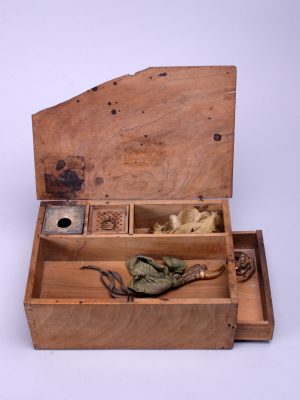
For image sources and permissions see our image gallery.
7. Online Resources
For relatively accessible information and bibliography on Anna Maria van Schurman by a leading van Schurman scholar Pieta van Beek, please visit:
For the most comprehensive catalogue of her letters to-date, please see Early Modern Letters Online‘s database of Anna Maria van Schurman correspondence by Samantha Sint Nicolaas:
For a solid list of important secondary sources with quick descriptions of each, please see:
- Lee, Bo Karen, and Anne Larsen. April 2019. “Anna Maria van Schurman.” Oxford Bibliographies, Renaissance and Reformation. https://www.oxfordbibliographies.com/view/document/obo-9780195399301/obo-9780195399301-0399.xml
For image sources and permissions see our image gallery.

